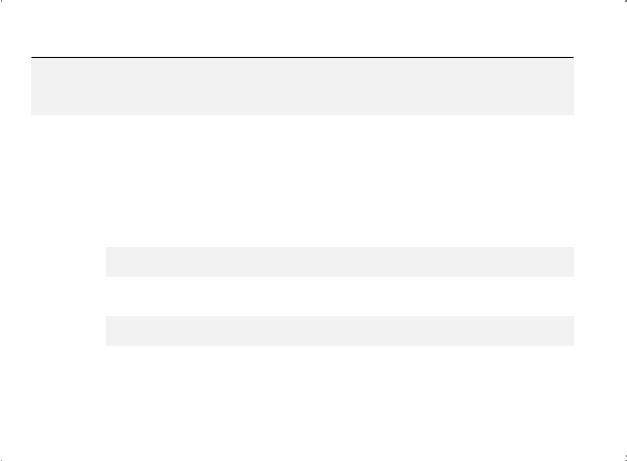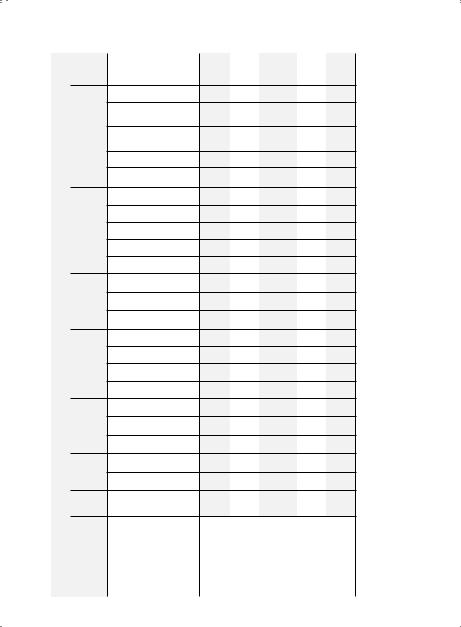
- •Abbreviations
- •1 Overview of Antimicrobial Therapy
- •Factors in Antibiotic Selection
- •Factors in Antibiotic Dosing
- •Microbiology and Susceptibility Testing
- •PK/PD and Other Considerations in Antimicrobial Therapy
- •Antibiotic Failure
- •Pitfalls in Antibiotic Prescribing
- •References and Suggested Readings
- •2 Empiric Therapy Based on Clinical Syndrome
- •Empiric Therapy of CNS Infections
- •Empiric Therapy of HEENT Infections
- •Empiric Therapy of Lower Respiratory Tract Infections
- •Empiric Therapy of GI Tract Infections
- •Empiric Therapy of Genitourinary Tract Infections
- •Empiric Therapy of Sexually Transmitted Diseases
- •Empiric Therapy of Bone and Joint Infections
- •Empiric Therapy of Skin and Soft Tissue Infections
- •Sepsis/Septic Shock
- •Febrile Neutropenia
- •Transplant Infections
- •Toxin-Mediated Infectious Diseases
- •Bioterrorist Agents
- •References and Suggested Readings
- •Gram Stain Characteristics of Isolates
- •Parasites, Fungi, Unusual Organisms in Blood
- •Parasites, Fungi, Unusual Organisms in CSF/Brain
- •Parasites, Fungi, Unusual Organisms in Lungs
- •Parasites, Fungi, Unusual Organisms in Heart
- •Parasites, Fungi, Unusual Organisms in the Liver
- •References and Suggested Readings
- •5 HIV Infection
- •HIV Infection Overview
- •Stages of HIV Infection
- •Acute (Primary) HIV Infection
- •Initial Assessment of HIV Infection
- •Indications for Treatment of HIV Infection
- •Antiretroviral Treatment
- •Treatment of Other Opportunistic Infections in HIV
- •HIV Coinfections (HBV/HCV)
- •References and Suggested Readings
- •6 Prophylaxis and Immunizations
- •Surgical Prophylaxis
- •Post-Exposure Prophylaxis
- •Chronic Medical Prophylaxis
- •Endocarditis Prophylaxis
- •Travel Prophylaxis
- •Tetanus Prophylaxis
- •Immunizations
- •References and Suggested Readings
- •Empiric Therapy of CNS Infections
- •Empiric Therapy of HEENT Infections
- •Empiric Therapy of Lower Respiratory Tract Infections
- •Empiric Therapy of Vascular Infections
- •Empiric Therapy of Gastrointestinal Infections
- •Empiric Therapy of Bone and Joint Infections
- •Empiric Therapy of Skin and Soft Tissue Infections
- •Common Pediatric Antimicrobial Drugs
- •References and Suggested Readings
- •8 Chest X-Ray Atlas
- •References and Suggested Readings
- •9 Infectious Disease Differential Diagnosis
- •11 Antimicrobial Drug Summaries
- •Appendix
- •Malaria in Adults (United States)
- •Malaria in Children (United States)
- •Index

178 |
A n t i b i o t i c E s s e n t i a l s |
Ebola/Lassa Fever
Clinical Presentation: After an incubation period of 3–9 days, abrupt onset of high fevers, severe headache/myalgias followed by diarrhea, extreme malaise.. Hemorrhagic phenomenon–GI, renal, vaginal, conjunctival bleeding-occur at 5–7 days.. Patients rapidly become critically ill.. Fever is biphasic.. Patients usually have leukopenia, thrombocytopenia, and hepatic/renal dysfunction.. Conjunctival suffusion is also an early finding in half the cases.. If a patient is not a traveler from an endemic area (e..g.., Africa), suspect bioterrorist Ebola/Lassa fever.. Lassa fever differs from Ebola in having prominent head/neck edema.. CNS finding (oculogyric crisis, seizures, deafness) are characteristic of Lassa fever..
Diagnostic Considerations: Ebola is a hemorrhagic fever clinically indistinguishable from Yellow fever and other African hemorrhagic fevers (e..g.., Lassa fever, Marburg virus disease).. Presumptive diagnosis is clinical; definitive diagnosis is confirmed by specific virologic/serologic studies..
Pitfalls: Patients with Ebola may complain initially of a sore throat and dry cough, with or without chest pain.. Diarrhea/abdominal pain is not uncommon.. The rash is maculopapular before it becomes hemorrhagic.. Failure to consider the diagnosis may occur early when sore throat/GI symptoms are prominent (i..e.., before hemorrhagic manifestations appear)..
Therapeutic Considerations: There is no effective therapy available for Ebola infection.. Supportive therapy can be life saving..
Prognosis: Varies with severity of infection and health of the host..
REFERENCES AND SUGGESTED READINGS
Azad AF. . Pathogenic rickettsiae as bioterrorism agents. . Clin Infec Dis 45 Suppl 1:S52–S55, 2007..
Alvarez-Lerma F, Grau S, Alvarez-Beltran. . Levofloxacin in the treatment of ventilator-associated pneumonia. . Clin Microbiol Infect 12:81–92, 2006..
Baddour LM, Bettmann MA, Bolger AF, et al.. Nonvascular cardiovascular device-related infections. . Circulation 108:2015–2031, 2003..
Bartlett JG, Inglesby TV, JR, Bono L. . Management of anthrax.. Clin Infect Dis 35:851–858, 2002..
Bouza E, Burillo A, Munoz P.. Antimicrobial Therapy of Clostridium difficile-associated diarrhea. . Med Clin N Am 90:1141–63, 2006..
Boyce JM. . Methicillin-resistant Staphylococcus aureus. . Lancet Infect Dis 5:653–663, 2005..
Bradley SF. . Infections in long-term-care residents. . Infect Med 22:168–172, 2005..
Breman JG, Henderson DA.. Diagnosis and management of smallpox.. N Engl J Med 346:1300–1308, 2002..
Carratala J, Martin-Herrero JE, Mykietiuk A, et al. . Clinical experience in the management of community -acquired pneumonia: lessons from the use of fluoroquinolones. . Clin Microbiol Infect 12:2–11, 2006..
Castro P, Soriano A, Escrich C, et al.. Linezolid treatment of ventriculoperitoneal shunt infection without implant
removal. . Eur J Clin Microbiol Infect Dis 24:603–06, 2005..
Celebi G, Baruonu F, Ayoglu F, et al.. Tularemia, a reemerging disease in northwest Turkey: epidemiological investigation and evaluation of treatment responses. . Jpn J Infect Dis 59:229–234, 2006..
Chalmers JD, Rother C, Salih W, et al.. Healthcare-associated pneumonia does not accurately identify potentially resistant pathogens: A systemic review and metaanalysis.. Clin Infect Dis 58:330-339, 2014..
Chastre J, Wolff M, Fagon JY, et al.. Comparison of 8 vs 15 days of antibiotic therapy for ventilator-associated pneumonia in adults.. JAMA 290:2588–2598, 2003..
Chen XM, Leithly JS, Paya CV, et al. . Cryptosporidiosis. . N Engl J Med 346:1723–1731, 2002..
Chiou CC, Does penicillin remain the drug of choice for pneumococcal pneumonia in view of emerging in vitro resistance? Clin Infect Dis 42:234–7, 2006..
Cunha BA. . Antibiotic selection in the penicillin-allergic patient.. Med Clin North Am 90:1257–64, 2006..
Cunha BA. . Antimicrobial therapy of multidrug-resistant Streptococcus pneumoniae, vancomycin-resistant enterococci, and methicillin-resistant Staphylococcus aureus.. Med Clin North Am 90:1165–82, 2006..

Chapter 2. Empiric Therapy Based on Clinical Syndrome |
179 |
Cunha BA. . The atypical pneumonias: clinical diagnosis and importance. . Clin Microbiol Infect 12:12–4, 2006..
Cunha BA. . Oral antibiotic therapy of serious systemic infections.. Med Clin North Am 90:1197–222, 2006..
Cunha BA. . Ventilator-associated pneumonia: monotherapy is optimal if chosen wisely.. Crit Care 10:141, 2006..
Cunha BA.. Herpes Simplex-1 (HSV-1) pneumonia.. Infect Dis Practice 29:375–78, 2005..
Cunha BA.. Malaria vs.. Typhoid fever: a diagnostic dilemma? Am J of Med 118:1442–43, 2005..
Cunha BA. . Methicillin-resistant Staphylococcus aureus: clinical manifestations and antimicrobial therapy. . Clin Microbiol Infect 11:33–42, 2005..
Cunha BA.. Pseudomonas aeruginosa: resistance and therapy.. Semin Respir Infect 17:231–9, 2002..
Cunha BA. . Clinical relevance of penicillin-resistant Strep tococcus pneumoniae. . Semin Respir Infect 17: 204–14, 2002..
Cunha BA.. Smallpox: An Oslerian primer.. Infectious Disease Practice 26:141–148, 2002..
Cunha BA. . Osteomyelitis in the elderly. . Clin Infect Dis 35:287–273, 2002..
Cunha BA.. Bioterrorism in the emergency room: Anthrax, tularemia, plague, ebola and smallpox.. Clinical Microbiology & Infection 8:489–503, 2002..
Cunha BA.. Central nervous system infections in the compromised host. . A diagnostic approach. . Infect Dis Clin 15:67–590, 2001..
Cunha BA.. Effective antibiotic resistance and control strategies.. Lancet 357:1307–1308, 2001..
Cunha BA.. Nosocomial pneumonia: Diagnostic and therapeutic considerations.. Medical Clinics of North America 85:79–114, 2001..
Cunha BA. . Community acquired pneumonia: diagnostic and therapeutic considerations. . Medical Clinics of North America 85:43–77, 2001..
Cunha BA.. Pneumonias in the compromised host.. Infect Dis Clin 15:591–612, 2001..
Cunha BA.. Community-acquired pneumonias re-revisited.. Am J Med 108:436–437, 2000..
Daver NG, Shelburne SA, Atmar RL, et al. . Oral step -down therapy is comparable to intravenous therapy for Staphylococcus aureus osteomyelitis.. Journal of Infection 54:539–544, 2007..
Dangerfield B, Chung A, Webb B, et al.. Predictive value of methicillin-resistant Staphylococcus aureus (MRSA) nasal swab PCR assay for MRSA pneumonia.. Antimicrob Agents Chemother 58:589-864, 2014..
Dunning J, Baillie JK, Cao B, et al.. Antiviral combinations for severe influenza.. Lancet 14:1259-1270, 2014..
Eckburg PB, Schneider JJ, Renault CA. . Avian influenza in humans: A practical review for clinicians. . Infect Med 22:535–542, 2005..
Esposito S, Bosis S, Semino M, et al.. Infections and systemic lupus erythematosus.. Eur J Clin Microbiol & Infect Dis 33:1467-1475, 2014..
Fihn SD. . Acute uncomplicated urinary tract infection in women.. N Engl J Med 349:259–66, 2003..
File TM Jr. . Community-acquired pneumonia. . Lancet 362:1991–2001, 2003..
Fishbain J, Peleg AY.. Treatment of Acinetobacter Infections.. Clin Infect.. Dis.. 51:79–84, 2010..
Fishman, JA.. Infection in solid-organ transplant recipients.. N Engl J Med 357:2601–2614, 2007..
Furin J, Nardell EA. . Multidrug-resistant tuberculosis: An update on the best regimens.. J Respir Dis 27:172–82, 2006..
Gagliotti C, Nobilio L, Milandri M, et al.. Macrolide prescriptions and erythyromycin resistance for Streptococcus
pyogenes.. Clin Infect Dis 42:1153–6, 2006..
Gomes CC, Vormittag E, Santos CR, Levin AS. . Nosocomial infection with cefalosporin-resistant Klebsiella pneumoniae Is not associated with increased mortality.. Infect Control and Hosp Epidemiol 27:907–12, 2006..
Gould IM. . The clinical significance of methicillin-resistant Staphylococcus aureus.. J Hosp Infect 61:277–282, 2005..
Gupta R, Warren T, Wald A. . Genital herpes. . Lancet 370: 2127–2137, 2007..
Haque NZ, Zervos MJ.. Vancomycin-Resistant Enterococcal Infections: clinical manifestations and Management. . Infections in Medicine 23:14–19, 2006..
Hayakawa K, Nakagawa K.. Treatment of infected total knee arthroplasty.. Infect Diseases in Clin Practice 14:211–215, 2006..
Heldman AW, Hartert TV, Ray SC, et al. . Oral antibiotic treatment of right-sided staphylococcal endocarditis in injection drug users: prospective randomized comparison with parenteral therapy. . Am J Med 101: 68–76, 1996..
Johnson DH, Cunha BA. . Infections in alcoholic cirrhosis. . Infectious Disease Clinics 16:363–372, 2001..
Johnson LB, Saravolatz LD. . Community-acquired MRSA: current epidemiology and management issues.. Infections in Medicine 23:6–10, 2006..
Joseph SM, Peiris MD, D.. Phil et al.. The severe acute respiratory syndrome.. N Engl J Med 349:2431–41, 2003..
Kallen AJ, Mu Y, Bulens S, et al. . Health care-associated invasive MRSA infections, 2005–2008. . JAMA 304: 641–648, 2010..

180 |
A n t i b i o t i c E s s e n t i a l s |
Kanafani ZA, Khalife N, Kanj SS, Araj GF, Khalifeh M, Sharara AI. . Antibiotic use in acute cholecystitis: practice patterns in the absence of evidence-based guidelines. . J Infect 51:128–134, 2005..
Kassakian SZ, Mermel LA. . Changing epidemiology of infections due to extended spectrum betalactamase producing bacteria. . Antimicrob Resist Infect Control 25:9, 2014..
Kauffman CA. . Managing fungal pneumonias: a review of the new therapies.. J Crit Illness 20:30–35, 2005..
Kauffman CA. . Endemic mycoses in patients with hematologic malignancies.. Semin Respir Infect 17:106–12, 2002..
Kawai N, Idematsu H, Iwaki N, et al. . Comparisons of the effectiveness of zanamivir and oseltamivir against influenza A/H1N1, A/H3N2, and B.. Clin Infect Dis 48:996–99, 2009..
Khardori N, Kanchanapoom T.. Overview of biological terrorism: Potential agents and preparedness.. Clin Microbiol News 27:1, 2005..
Kimberlin DW, Rouse DJ. . Genital herpes. . N Engl J Med 350:1970–7, 2004..
Kmeid JG, Youssef MM, Kanafani ZA, et al. . Combination therapy for Gram-negative bacteria: what is the evidence? Expert Rev Anti Infect Ther 11:1355-1362, 2013..
Kohli A, Shaffer A, Sherman A, et al.. Treatment of hepatitis C.. A systematic review.. J Am Med Assoc.. 312:631-640, 2014..
Lamas C. . Diagnostic strategy for blood culture-negative endocarditis.. Clin Infect.. Dis.. 51:141–142, 2010..
Leather HL, Wingard JR. . Infections following hematopoietic stem cell transplantation.. Infect Dis Clin North Am 15:483–520, 2001..
Linden PK. . Treatment options for vancomycin-resistant enterococcal infections.. Drugs 62: 425–41, 2002..
Lipsky BA, Byren I, Hoey CT.. Treatment of bacterial prostatitis.. Clin Infect Dis.. 50:1641–1652, 2010..
Loddenkemper R, Sagebiel D, Brendel A.. Strategies against multidrug-resistant tuberculosis. . Eur Respir J Suppl 36:66s-77s, 2002..
Maartens G, Wilinson RJ. . Tuberculosis. . Lancet 370:2030– 2043, 2007..
Martin-Pena A, Aguilar-Guisado M, Espigado I, Cisneros JM.. Antifungal combination therapy for invasive aspergillosis.. Clin Infect Dis 59:1437-1445, 2014..
McLaughlin SP, Carson CC. . Urinary tract infections in women.. Med Clin North Am 88:417–29, 2004..
Mead PA, Safdieh JE, Nizza P, et al.. Ommaya reservoir infections: A 16 year retrospective analysis.. Journal of Infection 68:225-230, 2014..
Meddings J, Rogers MAM, Macy M, et al.. Systematic review and meta-analysis: reminder systems to reduced catheter-associated urinary tract infections and urinary
catheter use in hospitalized patients. . Clin Infect Dis. . 51:550–560, 2010..
Mermel LA.. What is the Predominant Source of Intravascular Catheter Infections? Clin Infect Dis 52:211–212, 2011..
Metlay JP, Fishman NO, Joffe MM, et al. . Macrolide resistance in adults with bacteremic pneumococcal pneumonia.. Emerging Infect Dis 12:1223–30, 2006..
Michalopoulos A, Falagas ME.. Treatment of Acinetobacter infections. . Expert Opin Pharmacotherapy. . 11:779– 788, 2010..
Minnaganti V, Cunha BA.. Infections associated with uremia and dialysis.. Infect Dis Clin 16:385–406, 2001..
Musher DM, Musher BJ.. Contagious acute gastrointestinal infections.. N Engl J Med 351:2417–27, 2004..
Musher DM, Aslam S, Logan N, et al. . Relatively poor outcome after treatment of Clostridium difficile colitis with metronidazole.. Clin Infect Dis 40:1586–1590, 2005..
Mylonakis E, Calderwood SB. . Infective endocarditis in adults.. N Engl J Med 345:1318, 2001..
Nicholson KG, Wood JM, Zambon M. . Influenza. . Lancet 362:1733–45, 2003..
Nucci M, Anaissie E, Betts RF, et al.. Early removal of central venous catheter in patients with candidemia does not improve outcome: analysis of 842 patients from 2 randomized clinical trials.. Clin Infect.. Dis.. 51:295–303, 2010..
Parry CM, Hien TT, Dougan G, et al.. Typhoid fever.. N Engl J Med 347:1770–82, 2002..
Patterson KC, Strek M.. Diagnosis and treatment of pulmonary aspergillosis syndromes. . Chest 146:1358-1368, 2014..
Peipert JF. . Genital Chlamydial Infections. . N Engl J Med 349:2424–30, 2003..
Perea S, Patterson TF. . Invasive Aspergillus infections in hematologic malignancy patients. . Semin Respir Infect 17:99–105, 2002..
Perencevich EN, Diekema DJ.. Decline in invasive MRSA infection.. where to go from here? JAMA 304: 687–689, 2010..
Peterson LR. . Penicillin for treatment of pneumococcal pneumonia: does In vitro resistance really matter? Clin Infect Dis 42:224–33, 2006..
Pontoizeau C, Dangers L, Jarlier V, et al. . Ruling out False Positive Urinary Legionella pneumophila serogroup 1 and Streptococcus pneumonia antigen test results by heating urine.. J Clin Micro 52:4347-4349, 2014..
Razonable RR.. Management of cytomegalovirus infection after renal transplantation.. Infect Dis in Clinical Practice 17:220–230, 2009..

Chapter 2. Empiric Therapy Based on Clinical Syndrome |
181 |
Rex JH.. Approach to the treatment of systemic fungal infectious. . In: Kelley WN (ed), Kelley’s Textbook of Internal Medicine, 4th ed.., 2279–2281, 2000..
Rodriguez-Bano J.. Selection of empiric therapy in patients with catheter-related infections. . Clin Microbiol Infect 8:275–81, 2002..
Ross AGP, Bartley PB, Sleigh AC, et al. . Schistosomiasis. . N Engl J Med 346:1212–1220, 2002..
Rovers MM, Schilder AGM, Zielhuis GA, et al.. Otitis media.. Lancet 363:465–73, 2004..
Ruhe JJ, Monson T, Bradsher RW, Menon A. . Use of longacting tetracyclines for methicillin-resistant Staphylococcus aureus infections: case series and review of the literature.. Clin Infect Dis 40:1429–1434, 2005..
Safdar A, Bryan CS, Stinfon S, et al. . Prosthetic valve endocarditis due to vancomycin-resistant Enterococcus faecium: treatment with chloramphenicol plus minocycline.. Clin Infect Dis 34:61–3, 2002..
Sagnelli E, Santantonio T, Coppola N, et al.. Acute hepatitis C: clinical and laboratory diagnosis, course of the disease, treatment.. Infection 42:601-610, 2014..
Schoen RT.. Better laboratory testing for lyme disease: No more western blot.. Clin Infect Dis 57:341-343, 2013..
Slenczka W, Klenk HD.. Fort years of Marburg virus.. J Infect Dis 196:S131–S135, 2007..
Sobel JD.. Botulism.. Clin Infect Dis 41:1167–1173, 2005.. Sobel JD, Wiesenfeld HC, Martens M, et al.. Maintenance flu-
conazole therapy for recurrent vulvovaginal candidiasis.. N Engl J Med 351:876–83, 2004..
Spellberg BJ, Filler SG, Edwards JE. . Current treatment strategies for disseminated candidiasis. . Clin Infect Dis 42:244–251, 2006..
Steffen R, Hill DR, DuPont HL.. Traveler’s diarrhea: A clinical review.. JAMA 313:71-80, 2015..
Szvalb AD, Raad II, Weinberg JS, et al.. Ommaya reservoirrelated infections: Clinical manifestations and treatment outcomes.. Infection.. 68:216-224, 2014..
Tegnell A, Wahren B, Elgh G.. Smallpox - eradicated, but a growing terror threat.. Clin Microbiol Infect 8:504–509, 2002..
Teshae EH, Hu DJ, Holmberg SD.. The two faces of hepatitis E virus.. Clin Infect Dis.. 51:328–334, 2010..
Thielman NM, Guerrant RL. . Acute infectious diarrhea. . N Engl J Med 350:38–47, 2004..
Tolkoff-Rubin NE, Rubin RH.. Recent advances in the diagnosis and management of infection in the organ transplant recipient.. Semin Nephrol 20:148–163, 2000..
Tunkel AR, Hartman BJ, Kaplan SL, et al.. Practical guidelines for the management of bacterial meningitis.. Clin Infect Dis 39:1267–84, 2004..
van de Beek D, de Gans J, Spanjaard L, et al.. Clinical features and prognostic factors in adults with bacterial meningitis.. N Engl J Med 351:1849–59, 2004..
van de Beek D, de Gans J,Tunkel AR, Wijdicks EFM. . Community-acquired bacterial meningitis in adults. . N Engl J Med 354:44–53, 2006..
Viale P, STefani S.. Vascular catheter-associated infections: a microbiological and therapeutic update.. Journal of Chemotherapy 18:235–49, 2006..
Walsh TJ, Rex JH.. All catheter-related candidemia is not the same: assessment of the balance between the risks and benefits of removal of vascular catheters.. Clin Infect Dis 34:600–602, 2002..
Wilkie MD, Hanson MF, Statham PF, Brennan PM.. Infections of cerebrospinal fluid diversion devices in adults: The role of intraventricular antimicrobial therapy. . J Infection 63:239246, 2013..
Wormser, GP.. Discovery of new infections diseases Bartonella species.. N Engl J of Med 356:2346–2347, 2007..
Wormser, GP.. Early Lyme Disease.. N Engl J Med 354:2794– 801, 2006..
Wright AJ, Fishman JA.. Central nervous system syndromes in solid organ transplant recipients. . Clin Infect Dis 59:1001-1011, 2014..
GUIDELINES
Bisno AL, Gerber MA, Gwaltney JM Jr, Kaplan EL, Schwartz RH.. Practice guidelines for the diagnosis and management of group A streptococcal pharyngitis.. Infectious Diseases Society of America.. Clin Infect Dis 35:113–25, 2002..
CDC MMWR Sexually transmitted diseases treatment guidelines, 2010.. (RR-12) 59:1–110, 2010..
Chapman SW, Bradsher RW Jr, Cambell CD Jr, et al.. Practice guidelines for the management of patients with blastomycosis.. Infectious Diseases Society of America.. Clin Infect Dis 30:679–83, 2000..
Cordonnier C, Pautas C, Maury S, Vekhoff A, et al.. Empirical versus preemptive antifungal therapy for high-risk, febrile, neutropenic patients: A randomized, controlled trial.. Clin Infect Dis 48:1042–1051, 2009..
Dworkin RH, Johnson RW, Breuer J. . Recommendations for the management of Herpes zoster. . Clin Infect Dis 44:S1–26, 2007..
Dykewicz CA.. Summary of the guidelines for preventing opportunistic infectious among hematopoietic stem cell transplant recipients.. Clin Infect Dis 33:139–44, 2001..
File TM.. Recommendations for treatment of hospital-acquired and ventilator-associated pneumonia: review of recent international guidelines.. Clin Infect Dis.. 51:S42–S47, 2010..

182 |
A n t i b i o t i c E s s e n t i a l s |
Freifeld A, Bow E, Sepkowitz K, et al. Clinical Practice Guideline for the Use of Antimicrobial Agents in Neutropenic Patients with Cancer: 2010 Update by the Infectious Diseases Society of America.. Clin Infect Dis 52:e56–e93, 2011..
Galgiani JN, Ampel NM, Blair JE, et al.. Coccidioidomycosis.. Clin Infect Dis 41:1217–23, 2005..
Goodman EL.. Practice guidelines for evaluating new fever in critically ill adult patients.. Clin Infect Dis 30:234, 2000..
Guerrant RL, Van Gilder T, Sterner TS, et al.. Practice guidelines for the management of infectious diarrhea.. Clin Infect Dis 15:321–4, 2001..
Gupta K, Hooton T, Naber K, et al. . International Clinical Practice Guidelines for the Treatment of Acute Uncomplicated Cystitis and Pyleonephritis in Women: A 2010 Update by the Infectious Diseases Society of America and the European Society for Microbiology and infectious Diseases. . Clinical infectious Diseases. . 52:e103–e120, 2011..
Horsburgh CR Jr, Feldman S, Ridzon R. . Practice guidelines for the treatment of tuberculosis. . Clin Infect Dis 31:633–9, 2000..
Hughes WT, Armstrong D, Bodey GP, et at guidelines for the use of antimicrobial agents in neutropenic patients with cancer.. Clin Infect Dis 34:730–51, 2002..
Kauffman CA, Hajjeh R, Chapman SW.. Practice guidelines for the management of patients with sporotrichosis. . For the mycoses study group, Infectious Diseases Society of America.. Clin Infect Dis 30:684–7, 2000..
Krol V, Hamid NS, Cunha BA.. Neurosurgically related nosocomial Acinetobacter baumannii meningitis: report of two cases and literature review.. J Hospital Infection.. 71:176–180, 2009..
Lipsky BA, Berendt AR, Deery HG, et al.. Diagnosis and treatment of diabetic foot infections.. Infect Dis 39:885–910, 2004..
Liu C, Bayer A, Cosgrove S, et al. . Clinical Practice Guidelines by the Infectious Diseases Society of America for the Treatment of Methicillin-Resistant Staphylococcus Aureus Infections in Adults and Children.. Clinical Infectious Diseases.. 52:1–38, 2011..
Mandell LA, Wunderink RG, Anzueto A, et al. . Infectious diseases society of america/american thoracic society consensus guidelines on the management of com- munity-acquired pneumonia in adults. . Clin Infect Dis 44(S2):S27–S72, 2007..
Marr K, Boeckh M.. Practice guidelines for fungal infections: a risk-guided approach.. Clin Infect Dis 32:331–51, 2001..
Mermel LA, Allon M, Bouza E, Craven DE, et al.. Clinical practice guidelines for the diagnosis and management of intravascular catheter-related infection: 2009 update by
the Infectious Diseases Society of America. . Clin Infect Dis 49:1–45, 2009..
Nicolle LE, Bradley S, Colgan R, et al. . Infectious Diseases Society of America guidelines for the diagnosis and treatment of asymptomatic bacteriuria in adults. . Clin Infect Dis 40:643–54, 2005..
O’Grady NP, Barie PS, Bartlett JG, et al.. Practice guidelines for evaluating new fever in critically ill adult patients.. Clin Infect Dis 26:1042–1059, 1998..
Pappas PG, Rex JH, Sobel JD, et al.. Guidelines for treatment of candidiasis.. Clin Infect Dis 38:161–89, 2004..
Pappas PG, Kauffman CA, Andes D, et al. . Clinical practice guidelines for the management of candidiasis: 2009 update by the Infectious Diseases Society of America.. Clin Infect Dis 48:503–535, 2009..
Rolston KV. . The Infectious Diseases Society of America 2002 guidelines for the use of antimicrobial agents in patients with cancer and neutropenia: salient features and comments.. Clin Infect Dis 39 Suppl 1:S44-8, 2004..
Rubin LG, Levin MJ, Ljungman P, et al. . 2013 IDSA Clinical Practice Guideline for Vaccination of the Immunocompromised Host.. Clin Infect Dis 58:309-318, 2014..
Saag MS, Graybill RJ, Larsen RA, Pappas PG, et al.. Practice guidelines for the management of cryptococcal disease.. Infectious Diseases Society of America.. Clin Infect Dis 30:710-8, 2000..
Sobel JD.. Practice guidelines for the treatment of fungal infections. . For the mycoses study group. . Infectious diseases society of america.. Clin Infect Dis 30:652, 2000..
Solomkin JS, Mazuski JE, Bradley JS, et al. . Diagnosis and management of complicated intra-abdominal infection in adults and children: guidelines by the surgical infection society and the infectious diseases society of america.. Clin Infect.. Dis 50:133–164, 2010..
Solomon JS, Mazuski JE, Baron EJ, et al.. Guidelines for the selection of anti-infective agents for complicated intraabdominal infections.. Clin Infect Dis 37:997–1005, 2003..
Stevens DA, Dan VL, Judson MA, Morrison VA, et al.. Practice guidelines for diseases caused by Aspergillus.. infectious diseases society of america.. Clin Infect Dis 30:696–709, 2000..
Stevens DL, Bisno AL, Chambers HF, et al.. Practice guidelines for the diagnosis and management of skin and soft tissue infections. . Clin Infect Dis 41:1373–1406, 2005..
Stevens DL, Bisno AL, Chambers HF, et al.. Practice guidelines for the diagnosis and management of skin and soft tissue infections.. Clin Infect Dis 59:147–159, 2014..
Talmor M, Li P, Barie PS.. Acute paranasal sinusitis in critically ill patients: guidelines for prevention, diagnosis, and treatment.. Clin Infect Dis 25:1441–6, 1997..

|
Chapter 2. Empiric Therapy Based on Clinical Syndrome |
183 |
||
Tice AD, Rehm SJ, Dalovisio JR, et al. . Practice guidelines |
Cimolai N (ed).. Laboratory Diagnosis of Bacterial Infections.. |
|||
for outpatient parenteral antimicrobial therapy. . IDSA |
New York, Marcel Dekker, 2001.. |
|
||
guidelines.. Clin Infect Dis 38:1651–72, 2004.. |
Cohen J, Powderly WG, Opal S (Eds). . Infectious Diseases |
|||
Tunkel AR, Hartman BJ, Kaplan SL, et al.. Practice guidelines |
(4th Ed).. Elsevier, Philadelphia 2015.. |
|
||
for the management of bacterial meningitis.. Clin Infect |
Cunha BA (ed).. Infectious Disease in Critical Care Medicine (3rd |
|||
Dis 39:1267–1284, 2004.. |
Ed), Informa Healthcare, New York, 2010.. |
|||
Wheat LJ, Freifeld AG, Kleiman MB, et al. . Clinical practice |
Cunha BA (ed). . Tick-Borne Infectious |
Diseases. . Marcel |
||
guidelines for the management of patients with histo- |
||||
Dekker, New York, 2005.. |
|
|||
plasmosis: 2007 update by the Infectious Diseases Soci- |
|
|||
Cunha BA (ed). . Infectious Disease in |
the Elderly. . John |
|||
ety of America.. Clin Infect Dis 45:807–25, 2007.. |
||||
Wright & Co.., London, 1988.. |
|
|||
Wheat LJ, Musial CE, Jenny-Avital E.. Diagnosis and manage- |
|
|||
Despommier DD, Gwadz RW Hotez PJ, Knirsh CA (eds).. Para- |
||||
ment of central nervous system histoplasmosis. . Clin |
||||
sitic Diseases (5th Ed), Apple Tree Productions, LLC, New |
||||
Infect Dis 40:844–852, 2005.. |
York, New York, 2005.. |
|
||
Workowski KA. . Sexually transmitted diseases treatment |
|
|||
Faro S, Soper DE (eds).. Infectious Diseases in Women.. WB |
||||
guidelines.. Clin Infect Dis 44:S73–174, 2007.. |
||||
Saunders Company, Philadelphia, 2001.. |
||||
Wormser GP, Nadelman RB, Battwyler RJ, et al. . Practice |
||||
Farrar J (eds).. Manson’s Tropical Diseases (23rd Ed).. Elsevier |
||||
guidelines for the treatment of Lyme disease.. Infectious |
Saunders, London, 2014.. |
|
||
Disease Society of America.. Clin infect Dis 31 (Suppl 1): |
|
|||
Glauser MP, Pizzo PA (eds). . Management of Infection in |
||||
1–14, 2000.. |
|
|||
|
Immunocompromised Patients.. W..B.. Saunders, London, |
|||
Yu VL, Ramirez J, Roig J, et al. . Legionnaires disease and |
||||
2000.. |
|
|||
the updated IDSA guidelines for community-acquired |
|
|||
Gorbach SL, Bartlett JG, Blacklow NR (eds). . Infectious |
||||
pneumonia.. Clin Infect Dis 39:1734–7, 2004.. |
||||
Diseases (3rd Ed), Philadelphia, Lippincott, Williams & |
||||
TEXTBOOKS |
|
Wilkins, 2004.. |
|
|
|
Grayson ML (ed).. Kucers’ The Use of Antibiotics (6th Ed), ASM |
|||
Arikan S Rex JH (eds).. Antifungal Drugs in Manual of Clinical |
||||
Press, Washington, DC, 2010.. |
|
|||
Microbiology (8th Ed), 2003.. |
|
|||
Guerrant RL, Walker DH, Weller PF (eds).. Tropical Infectious |
||||
Baddour L, Gorbach SL (eds).. Therapy of Infectious Diseases .. |
||||
Disease: Principles, Pathogens & Practice (3rd Ed), Else- |
||||
Saunders, Philadelphia, Pennsylvania, 2003.. |
||||
vier, Philadelphia, 2011.. |
|
|||
Bennett JE, Dolin R, Blaser MJ (eds).. Mandell, Douglas, and |
|
|||
Halperin JJ.. Encephalitis: Diagnosis and Treatment.. Informa |
||||
Bennett’s Principles and Practice of infectious Diseases |
||||
Healthcare, New York, 2008.. |
|
|||
(8th Ed), Elsevier Churchill Livingstone, 2015.. |
|
|||
Bodey GP, Feinstein V (eds). . Candidiasis. . New York, Raven |
Hauser AR, Rello J (eds).. Severe Infections Caused by Pseu- |
|||
domonas Aeruginosa. . Kluwer Academic Publishers, |
||||
Press, 1985.. |
|
|||
|
Boston, Massachusetts, 2003.. |
|
||
Bowden RA, Ljungman P, Snydman DR (eds). . Transplant |
|
|||
Koff RS Hepatitis Essentials, Jones & Bartlett, Sudbury, MA, |
||||
Infections (3rd Ed), Lippincott Williams & Wilkins, Phila- |
||||
delphia, PA, 2010.. |
2011.. |
|
||
Madkour MM (ed). . Tuberculosis. . Springer-Verlag, Berlin |
||||
Brandstetter R, Cunha BA, Karetsky M (eds).. The Pneumo- |
||||
nias.. Mosby, Philadelphia, 1999.. |
Germany, 2004.. |
|
||
Brook I (ed).. Sinusitis.. Taylor & Francis Group, New York, New |
Maertens JA, Marr KA. . Diagnosis of Fungal Infections. . |
|||
York, 2006.. |
|
Informa Healthcare, New York, 2007.. |
|
|
Brusch JL Endocarditis Essentials.. Jones & Bartlett, Sudbury, |
McMillan A, Young H, Ogilvie MM, Scott GR (eds).. Clinical |
|||
MA, 2010.. |
|
practice in Sexually Transmissible Infections, Saunders, |
||
Brusch, JL.. Infective Endocarditis: Management in the Era |
London, England, 2002.. |
|
||
of Intravascular Devices.. Informa Healthcare, New York |
Pilch RF, Ziliinskas RA (eds). . Encyclopedia of Bioterror- |
|||
2007.. |
|
ism Defense.. Wiley-Liss, Hoboken, New Jersey, 2005.. |
||
Bryskier A (ed). . Antimicrobial Agents. . ASM Press, |
Raoult D, Parola P.. Rickettsial Diseases.. Informa Healthcare, |
|||
Washington, |
D..C.., 2005.. |
New York, 2007.. |
|
|
Calderone RA (ed). . Candida and Candidiasis. . ASM Press, |
Rom WN, Garay SM (eds).. Tuberculosis.. Lippincott Williams & |
|||
Washington DC, 2002.. |
Wilkins, Philadelphia, Pennsylvania, 2004.. |
|||

184 |
A n t i b i o t i c E s s e n t i a l s |
Scheld W, Whitley R, Marra C (eds).. Infections of the Central Nervous System (3rd Ed), Lippincott Williams & Wilkins, Philadelphia, 2005..
Schlossberg D (ed).. Tuberculosis & Nontuberculous Mycobacterial Infections (6th Ed), New York, McGraw-Hill, 2011..
Schlossberg D (ed). . Clinical Infections Diseases (2nd Ed), Cambridge University Press, London, 2015..
Schlossberg D (ed).. Current Therapy of Infectious Disease (3rd Ed), Mosby-Yearbook, St.. Louis, 2008..
Schlossberg D (ed).. Medical Interventions for Bioterrorism and Emerging Infections.. Handbooks in Healthcare Co.., Newtown, Pennsylvania, 2004..
Singh N, Aguado JM (eds). . Infectious Complications in Transplant Patients.. Kluwer Academic Publishers, Boston, 2000..
Studahl M, Cinque P, Bergstrom T (eds). . Herpes Simplex Viruses. . Taylor & Francis Group, New York, New York, 2006..
Wingard JR, Anaissie EL (eds). . Fungal Infections in the Immunocompromised Patient.. Taylor & Francis Group, Boca Raton, Florida, 2005..
Woods JB (ed). . USAMRIID’s Medical management of biological casualties handbook (6th Ed), US Army Medical Research Institute of Infections Disease, Fort Detrick, Frederick, Maryland, 2005..
Yoshikawa TT, Rajagopalan S (eds). . Antibiotic Therapy for Geriatric Patients. . Taylor & Francis Group, New York, New York, 2006..
Yu, V, Edwards G, McKinnon PS, Peloquin C, Morse G (eds).. Antimicrobial Therapy and Vaccines, Volume II: Antimicrobial Agents (2nd Ed), ESun Technologies, Pittsburgh, Pennsylvania, 2005..

Chapter 3. Antibiotic Susceptibility Profiles and Initial Therapy |
185 |
Chapter 3
Antibiotic Susceptibility Profiles and Initial Therapy of
Isolates Pending Susceptibility Results
Burke A. Cunha, MD, Paul E. Schoch, PhD, Edward J. Bottone, PhD
John H. Rex, MD, Cheston B. Cunha, MD
Antibiotic Susceptibility Profiles (Tables 3.1–3.3).
Table 3.1. Antibiotic Susceptibility Profiles (Penicillins, Macrolides, Tetracyclines, Clindamycin, Metronidazole, Rifampin, TMP-SMX,
and Chloramphenicol) 186 Table 3.2. Antibiotic Susceptibility Profiles (Cephalosporins) 191 Table 3.3. Antibiotic Susceptibility Profiles (Aminoglycosides, Fluoroquinolones,
Colistin, Polymyxin B, Aztreonam, Tigecycline, Vancomycin, Quinupristin/Dalfopristin, Linezolid, Tedizolid, Daptomycin, Telavancin, Dalbavancin, Oritavancin, Nitrofurantoin, Fosfomycin, and Carbapenems) 198
Gram Stain Characteristics of Isolates (by Morphology, Arrangement,
Oxygen Requirements) . . . . . . . . . . . . . . . . . . . . . . . . .203-206 Table 3.4. Key Factors in Antibiotic Selection (Isolate Known) 207 Table 3.5. Antibiotic Selection Based on Resistance Potential . . . . . . . . . 207
To determine the Clinical Significance of an Isolate in Selecting Appropriate Initial Antibiotic Therapy Pending Susceptibility Testing (Tables 3.6–3.9)
Table 3.6. Clinical Significance of AEROBIC Isolates
Pending Susceptibility Testing 208 Table 3.7. Clinical Significance of CAPNOPHILIC Isolates
Pending Susceptibility Testing 235 Table 3.8. Clinical Significance of ANAEROBIC Isolates
Pending Susceptibility Testing 236 Table 3.9. Clinical Significance of YEAST/FUNGI
Pending Susceptibility Testing 242 Table 3.10. Technique for Gram Stain and Giemsa Stain 246 Table 3.11. Clinical Use of CSF Gram Stain, WBC Type, Glucose 246 Table 3.12. Clinical Use of the Sputum Gram Stain 248 Table 3.13. Clinical Use of the Urine Gram Stain 248 Table 3.14. Clinical Use of the Fecal Gram Stain 249 References and Suggested Readings 249
If isolate is a pathogen (P), in the appropriate body site, pathogens should be treated. Pathogens isolated from body sites not causing infections at the site cultured should ordinarily not be treated, e.g., S. pneumoniae from urine or a wound. Non-pathogens (NP), colonizers (C), or skin contaminants (C*) ordinarily should not be "covered" or treated.

Table 3.1. Antibiotic Susceptibility Profiles (Penicillins, Macrolides, Tetracyclines, and Others)
|
|
|
|
|
|
|
|
|
|
Anti- |
|
|
|
|
|
|
|
|
|
|
|
|
|
|
|
|
|
|
|
|
|
|
|
|
|
|
Pseudomonal |
|
|
|
|
|
|
|
Tetra- |
|
|
|
|
|
|
||||
|
|
|
Penicillins |
|
|
|
|
Penicillins |
|
Macrolides |
|
Cyclines |
Miscellaneous |
|
|||||||||||||
|
|
|
|
|
|
|
|
|
|
|
|
|
|
|
|
|
|
|
|
|
|
|
|
|
|
|
|
ORGANISMS |
(IV)GPenicillin |
(PO)VPenicillin |
(IV/PO)Ampicillin |
Ampicillin/Sulbactam(IV) |
(PO)Amoxicillin |
Amoxicillin/ Clavulanate(PO) |
(IV)Nafcillin |
(IV)Ticarcillin |
|
Ticarcillin/ Clavulanate(IV) |
(IV)Piperacillin |
Piperacillin/ Tazobactam(IV) |
Erythromycin(IV/PO) |
|
Clarithromycin(PO) |
Azithromycin(IV/PO) |
|
Telithromycin(PO) |
Tetracycline(IV/PO) |
|
Doxycycline(IV/PO) |
Minocycline(IV/PO) |
Clindamycin(IV/PO) |
Metronidazole(IV/PO) |
(PO)Rifampin |
(IV/PO)SMX-TMP |
Chloramphenicol(IV/PO) |
|
|
|
|
|
|
|
|
|
|
|
|
|
|
|
|
|
|
|
|
|
|
|
|
|
|
|
|
Aerobic Gram Positive |
|
|
|
|
|
|
|
|
|
|
|
|
|
|
|
|
|
|
|
|
|
|
|
|
|
|
|
Cocci (Clusters) |
|
|
|
|
|
|
|
|
|
|
|
|
|
|
|
|
|
|
|
|
|
|
|
|
|
|
|
|
|
|
|
|
|
|
|
|
|
|
|
|
|
|
|
|
|
|
|
|
|
|
|
|
|
|
|
Staphylococcus aureus |
0 |
0 |
1 |
2 |
0 |
2 |
3 |
0 |
|
0 |
0 |
3 |
3 |
|
0 |
0 |
|
0 |
0 |
|
2 |
1 |
1 |
0 |
2 |
1 |
2 |
(MSSA) |
|
|
|
|
|||||||||||||||||||||||
|
|
|
|
|
|
|
|
|
|
|
|
|
|
|
|
|
|
|
|
|
|
|
|
|
|
|
|
|
|
|
|
|
|
|
|
|
|
|
|
|
|
|
|
|
|
|
|
|
|
|
|
|
|
|
|
Staphylococcus aureus |
0 |
0 |
0 |
0 |
0 |
0 |
0 |
0 |
|
0 |
0 |
0 |
0 |
|
0 |
0 |
|
0 |
0 |
|
2† |
1 |
2† |
0 |
2 |
3† |
0 |
(HA/CO-MRSA) |
|
|
|
|
|||||||||||||||||||||||
|
|
|
|
|
|
|
|
|
|
|
|
|
|
|
|
|
|
|
|
|
|
|
|
|
|
|
|
S. aureus (CA-MRSA) |
0 |
0 |
0 |
0 |
0 |
0 |
0 |
0 |
|
0 |
0 |
0 |
0 |
|
0 |
0 |
|
|
0 |
|
2 |
1 |
2 |
0 |
0 |
2 |
0 |
|
|
|
|
|
|
|
|
|
|
|
|
|
|
|
|
|
|
|
|
|
|
|
|
|
|
|
|
S. epidermidis (CoNS) |
0 |
0 |
0 |
0 |
0 |
0 |
0 |
0 |
|
0 |
0 |
0 |
0 |
|
0 |
0 |
|
0 |
0 |
|
2 |
2 |
2 |
0 |
2 |
2 |
0 |
|
|
|
|
|
|
|
|
|
|
|
|
|
|
|
|
|
|
|
|
|
|
|
|
|
|
|
|
Aerobic Gram Positive |
|
|
|
|
|
|
|
|
|
|
|
|
|
|
|
|
|
|
|
|
|
|
|
|
|
|
|
Cocci (Chains) |
|
|
|
|
|
|
|
|
|
|
|
|
|
|
|
|
|
|
|
|
|
|
|
|
|
|
|
|
|
|
|
|
|
|
|
|
|
|
|
|
|
|
|
|
|
|
|
|
|
|
|
|
|
|
|
Enterococcus faecalis |
0 |
0 |
1 |
2 |
1 |
1 |
0 |
2 |
|
2 |
2 |
2 |
3 |
|
0 |
0 |
|
0 |
0 |
|
0 |
0 |
0 |
0 |
0 |
3 |
3 |
(VSE) |
|
|
|
|
|||||||||||||||||||||||
|
|
|
|
|
|
|
|
|
|
|
|
|
|
|
|
|
|
|
|
|
|
|
|
|
|
|
|
|
|
|
|
|
|
|
|
|
|
|
|
|
|
|
|
|
|
|
|
|
|
|
|
|
|
|
|
Enterococcus faecium |
0 |
0 |
0 |
0 |
0 |
0 |
0 |
0 |
|
0 |
0 |
0 |
0 |
|
0 |
0 |
|
0 |
0 |
|
3 |
2 |
0 |
0 |
0 |
0 |
3 |
(VRE)†† |
|
|
|
|
|||||||||||||||||||||||
|
|
|
|
|
|
|
|
|
|
|
|
|
|
|
|
|
|
|
|
|
|
|
|
|
|
|
|
Streptococci |
1 |
1 |
2 |
2 |
1 |
2 |
0 |
2 |
|
2 |
2 |
2 |
3 |
|
3 |
3 |
|
0 |
0 |
|
0 |
0 |
1 |
0 |
0 |
0 |
3 |
(Groups A, B, C, F, G) |
|
|
|
|
|||||||||||||||||||||||
|
|
|
|
|
|
|
|
|
|
|
|
|
|
|
|
|
|
|
|
|
|
|
|
|
|
|
|
|
|
|
|
|
|
|
|
|
|
|
|
|
|
|
|
|
|
|
|
|
|
|
|
|
|
|
|
186
s l a i t n e s s E c i t o i b i t n A

Streptococcus (bovis) |
|
1 |
1 |
|
2 |
2 |
1 |
|
2 |
0 |
2 |
2 |
2 |
2 |
|
3 |
0 |
0 |
0 |
|
0 |
0 |
|
0 |
|
0 |
0 |
0 |
|
0 |
0 |
galloyticus |
|
|
|
|
|
|
|
|
|||||||||||||||||||||||
|
|
|
|
|
|
|
|
|
|
|
|
|
|
|
|
|
|
|
|
|
|
|
|
|
|
|
|
|
|
|
|
|
|
|
|
|
|
|
|
|
|
|
|
|
|
|
|
|
|
|
|
|
|
|
|
|
|
|
|
|
|
|
|
Viridans streptococci |
|
|
|
|
|
|
|
|
|
|
|
|
|
|
|
|
|
|
|
|
|
|
|
|
|
|
|
|
|
|
|
(S. mitior, milleri, mitis, |
|
1 |
1 |
|
2 |
2 |
1 |
|
2 |
0 |
2 |
2 |
2 |
3 |
|
3 |
3 |
3 |
0 |
|
0 |
0 |
|
0 |
|
2 |
0 |
0 |
|
0 |
3 |
mutans, oralis, sanguis, |
|
|
|
|
|
|
|
|
|||||||||||||||||||||||
|
|
|
|
|
|
|
|
|
|
|
|
|
|
|
|
|
|
|
|
|
|
|
|
|
|
|
|
|
|
|
|
parasanguis, salivarius) |
|
|
|
|
|
|
|
|
|
|
|
|
|
|
|
|
|
|
|
|
|
|
|
|
|
|
|
|
|
|
|
|
|
|
|
|
|
|
|
|
|
|
|
|
|
|
|
|
|
|
|
|
|
|
|
|
|
|
|
|
|
|
|
Aerobic Gram Positive |
|
|
|
|
|
|
|
|
|
|
|
|
|
|
|
|
|
|
|
|
|
|
|
|
|
|
|
|
|
|
|
Cocci (Pairs) |
|
|
|
|
|
|
|
|
|
|
|
|
|
|
|
|
|
|
|
|
|
|
|
|
|
|
|
|
|
|
|
|
|
|
|
|
|
|
|
|
|
|
|
|
|
|
|
|
|
|
|
|
|
|
|
|
|
|
|
|
|
|
|
Streptococcus |
|
1 |
1 |
|
3* |
2 |
1 |
|
2 |
0 |
2 |
2 |
2 |
2 |
|
3* |
3* |
3* |
2 |
|
3* |
1 |
|
2 |
|
1 |
0 |
3* |
|
3* |
3 |
pneumoniae (PSSP) |
|
|
|
|
|
|
|
|
|||||||||||||||||||||||
|
|
|
|
|
|
|
|
|
|
|
|
|
|
|
|
|
|
|
|
|
|
|
|
|
|
|
|
|
|
|
|
|
|
|
|
|
|
|
|
|
|
|
|
|
|
|
|
|
|
|
|
|
|
|
|
|
|
|
|
|
|
|
|
Streptococcus |
|
1 |
0 |
|
0* |
2 |
1 |
|
2 |
0 |
3 |
3 |
3 |
3 |
|
0 |
0 |
0 |
2 |
|
0 |
1 |
|
1 |
|
2 |
0 |
2 |
|
0 |
3 |
pneumoniae (PRSP) |
|
|
|
|
|
|
|
|
|||||||||||||||||||||||
|
|
|
|
|
|
|
|
|
|
|
|
|
|
|
|
|
|
|
|
|
|
|
|
|
|
|
|
|
|
|
|
|
|
|
|
|
|
|
|
|
|
|
|
|
|
|
|
|
|
|
|
|
|
|
|
|
|
|
|
|
|
|
|
Streptococcus |
|
0 |
0 |
|
0 |
0 |
0 |
|
0 |
0 |
0 |
0 |
0 |
0 |
|
0 |
0 |
0 |
2 |
|
0 |
2 |
|
3 |
|
3 |
0 |
3 |
|
0 |
3 |
pneumoniae (MDRSP) |
|
|
|
|
|
|
|
|
|||||||||||||||||||||||
|
|
|
|
|
|
|
|
|
|
|
|
|
|
|
|
|
|
|
|
|
|
|
|
|
|
|
|
|
|
|
|
|
|
|
|
|
|
|
|
|
|
|
|
|
|
|
|
|
|
|
|
|
|
|
|
|
|
|
|
|
|
|
|
Aerobic Gram |
|
|
|
|
|
|
|
|
|
|
|
|
|
|
|
|
|
|
|
|
|
|
|
|
|
|
|
|
|
|
|
Negative Cocci (Pairs) |
|
|
|
|
|
|
|
|
|
|
|
|
|
|
|
|
|
|
|
|
|
|
|
|
|
|
|
|
|
|
|
|
|
|
|
|
|
|
|
|
|
|
|
|
|
|
|
|
|
|
|
|
|
|
|
|
|
|
|
|
|
|
|
Neisseria gonorrhoeae |
|
0 |
0 |
|
0 |
2 |
0 |
|
2 |
0 |
0 |
2 |
0 |
2 |
|
3 |
0 |
2 |
0 |
|
3* |
2 |
|
2 |
|
0 |
0 |
2 |
|
0 |
3 |
|
|
|
|
|
|
|
|
|
|
|
|
|
|
|
|
|
|
|
|
|
|
|
|
|
|
|
|
|
|
|
|
Neisseria meningitidis |
|
1 |
2 |
|
2 |
2 |
2 |
|
2 |
0 |
2 |
0 |
2 |
0 |
|
0 |
0 |
0 |
0 |
|
0 |
3 |
|
3 |
|
0 |
0 |
2 |
|
0 |
2 |
|
|
|
|
|
|
|
|
|
|
|
|
|
|
|
|
|
|
|
|
|
|
|
|
|
|
|
|
|
|
|
|
Aerobic Gram Positive |
|
|
|
|
|
|
|
|
|
|
|
|
|
|
|
|
|
|
|
|
|
|
|
|
|
|
|
|
|
|
|
Bacilli |
|
|
|
|
|
|
|
|
|
|
|
|
|
|
|
|
|
|
|
|
|
|
|
|
|
|
|
|
|
|
|
|
|
|
|
|
|
|
|
|
|
|
|
|
|
|
|
|
|
|
|
|
|
|
|
|
|
|
|
|
|
|
|
Bacillus anthracis |
|
2 |
3 |
|
2 |
3 |
2 |
|
3 |
0 |
0 |
0 |
0 |
0 |
|
3 |
3 |
3 |
0 |
|
2 |
1 |
|
0 |
|
2 |
0 |
2 |
|
0 |
2 |
|
|
|
|
|
|
|
|
|
|
|
|
|
|
|
|
|
|
|
|
|
|
|
|
|
|
|
|
|
|
|
|
Corynebacterium |
|
2 |
2 |
|
0 |
0 |
0 |
|
0 |
0 |
0 |
0 |
0 |
0 |
|
0 |
0 |
0 |
0 |
|
0 |
0 |
|
0 |
|
0 |
0 |
0 |
|
0 |
0 |
diphtheriae |
|
|
|
|
|
|
|
|
|||||||||||||||||||||||
|
|
|
|
|
|
|
|
|
|
|
|
|
|
|
|
|
|
|
|
|
|
|
|
|
|
|
|
|
|
|
|
|
|
|
|
|
|
|
|
|
|
|
|
|
|
|
|
|
|
|
|
|
|
|
|
|
|||||||
1 = Preferred antibiotic—High degree |
of activity against the isolate and likely to be clinically effective, most strains susceptible, has |
a favorable |
PK/ |
||||||||||||||||||||||||||||
PD characteristics, has a |
good |
safety |
profile, |
and |
has a “low |
resistance” potential |
(see Chapter |
11 Drug |
Summaries |
for |
antibiotic |
dosing |
details). |
||||||||||||||||||
2 = Alternate choice—With many attributes of a preferred antibiotic. 3 = Acceptable, but preferably select an alternate antibiotic. 0 = No activity or no data or limited experience. * = May be effective initially but as a “high resistance” antibiotic potential, resistance may develop during/after therapy.
† = Preferably use another CA-MRSA antibiotic, e.g., minocycline. †† = Same for vancomycin resistant E. faecalis.
Therapy Initial and Profiles Susceptibility Antibiotic .3 Chapter
187

Table 3.1. Antibiotic Susceptibility Profiles (Penicillins, Macrolides, Tetracyclines, and Others) (cont’d)
|
|
|
|
|
|
|
|
|
|
Anti- |
|
|
|
|
|
|
|
|
|
|
|
|
|
|
|
|
|
|
|
|
|
|
|
|
|
|
|
Pseudomonal |
|
|
|
|
|
|
|
Tetra- |
|
|
|
|
|
|
|
||||
|
|
|
Penicillins |
|
|
|
|
Penicillins |
|
Macrolides |
|
Cyclines |
|
Miscellaneous |
|
|||||||||||||
|
|
|
|
|
|
|
|
|
|
|
|
|
|
|
|
|
|
|
|
|
|
|
|
|
|
|
|
|
ORGANISMS |
(IV)GPenicillin |
(PO)VPenicillin |
(IV/PO)Ampicillin |
Ampicillin/Sulbactam(IV) |
(PO)Amoxicillin |
Amoxicillin/ Clavulanate(PO) |
(IV)Nafcillin |
(IV)Ticarcillin |
|
Ticarcillin/ Clavulanate(IV) |
(IV)Piperacillin |
Piperacillin/ Tazobactam(IV) |
Erythromycin(IV/PO) |
|
Clarithromycin(PO) |
Azithromycin(IV/PO) |
|
Telithromycin(PO) |
Tetracycline(IV/PO) |
|
Doxycycline(IV/PO) |
Minocycline(IV/PO) |
Clindamycin(IV/PO) |
Metronidazole(IV/PO) |
(PO)Rifampin§ |
(IV/PO)SMX-TMP |
|
Chloramphenicol(IV/PO) |
|
|
|
|
|
|
|
|
|
|
|
|
|
|
|
|
|
|
|
|
|
|
|
|
|
|
|
|
|
Corynebacterium jeikeium |
0 |
0 |
0 |
0 |
0 |
0 |
0 |
0 |
|
0 |
0 |
0 |
0 |
|
0 |
0 |
|
0 |
0 |
|
0 |
0 |
0 |
0 |
2 |
0 |
|
0 |
(JK) |
|
|
|
|
|
|||||||||||||||||||||||
|
|
|
|
|
|
|
|
|
|
|
|
|
|
|
|
|
|
|
|
|
|
|
|
|
|
|
|
|
|
|
|
|
|
|
|
|
|
|
|
|
|
|
|
|
|
|
|
|
|
|
|
|
|
|
|
|
|
Listeria monocytogenes |
2 |
2 |
1 |
2 |
1 |
2 |
0 |
2 |
|
2 |
2 |
2 |
3 |
|
0 |
0 |
|
0 |
3 |
|
3 |
3 |
0 |
0 |
2 |
1 |
|
1 |
|
|
|
|
|
|
|
|
|
|
|
|
|
|
|
|
|
|
|
|
|
|
|
|
|
|
|
|
|
Nocardia |
0 |
0 |
0 |
0 |
0 |
0 |
0 |
0 |
|
0 |
0 |
0 |
0 |
|
0 |
0 |
|
0 |
3 |
|
1 |
2 |
0 |
0 |
0 |
1 |
|
0 |
|
|
|
|
|
|
|
|
|
|
|
|
|
|
|
|
|
|
|
|
|
|
|
|
|
|
|
|
|
Aerobic Gram- |
|
|
|
|
|
|
|
|
|
|
|
|
|
|
|
|
|
|
|
|
|
|
|
|
|
|
|
|
Negative Bacilli |
|
|
|
|
|
|
|
|
|
|
|
|
|
|
|
|
|
|
|
|
|
|
|
|
|
|
|
|
|
|
|
|
|
|
|
|
|
|
|
|
|
|
|
|
|
|
|
|
|
|
|
|
|
|
|
|
|
Acinetobacter sp. |
0 |
0 |
0 |
1 |
0 |
0 |
0 |
0 |
|
3 |
0 |
3 |
0 |
|
0 |
0 |
|
0 |
0 |
|
3 |
2 |
0 |
0 |
3 |
3 |
|
0 |
|
|
|
|
|
|
|
|
|
|
|
|
|
|
|
|
|
|
|
|
|
|
|
|
|
|
|
|
|
Aeromonas hydrophila |
0 |
0 |
0 |
3 |
0 |
3 |
0 |
3 |
|
3 |
3 |
3 |
0 |
|
0 |
0 |
|
0 |
0 |
|
2 |
3 |
0 |
0 |
0 |
2 |
|
2 |
|
|
|
|
|
|
|
|
|
|
|
|
|
|
|
|
|
|
|
|
|
|
|
|
|
|
|
|
|
Bordetella sp. |
0 |
0 |
0 |
0 |
0 |
0 |
0 |
0 |
|
0 |
0 |
0 |
1 |
|
1 |
1 |
|
3 |
3 |
|
3 |
3 |
0 |
0 |
3 |
2 |
|
3 |
|
|
|
|
|
|
|
|
|
|
|
|
|
|
|
|
|
|
|
|
|
|
|
|
|
|
|
|
|
Brucella sp. |
0 |
0 |
0 |
0 |
0 |
0 |
0 |
0 |
|
0 |
0 |
0 |
0 |
|
0 |
0 |
|
0 |
3 |
|
2 |
3 |
0 |
0 |
3 |
3 |
|
3 |
|
|
|
|
|
|
|
|
|
|
|
|
|
|
|
|
|
|
|
|
|
|
|
|
|
|
|
|
|
Burkholderia |
0 |
0 |
0 |
0 |
0 |
0 |
0 |
0 |
|
0 |
0 |
0 |
0 |
|
0 |
0 |
|
0 |
0 |
|
3 |
2 |
0 |
0 |
0 |
3 |
|
3 |
(Pseudomonas) cepacia |
|
|
|
|
|
|||||||||||||||||||||||
|
|
|
|
|
|
|
|
|
|
|
|
|
|
|
|
|
|
|
|
|
|
|
|
|
|
|
|
|
|
|
|
|
|
|
|
|
|
|
|
|
|
|
|
|
|
|
|
|
|
|
|
|
|
|
|
|
|
Citrobacter sp. |
0 |
0 |
0 |
0 |
0 |
0 |
0 |
3 |
|
3 |
3 |
3 |
0 |
|
0 |
0 |
|
0 |
0 |
|
0 |
0 |
0 |
0 |
0 |
3 |
|
3 |
|
|
|
|
|
|
|
|
|
|
|
|
|
|
|
|
|
|
|
|
|
|
|
|
|
|
|
|
|
Enterobacter sp. |
0 |
0 |
0 |
0 |
0 |
0 |
0 |
3 |
|
3 |
3 |
3 |
0 |
|
0 |
0 |
|
0 |
0 |
|
0 |
0 |
0 |
0 |
0 |
3 |
|
0 |
|
|
|
|
|
|
|
|
|
|
|
|
|
|
|
|
|
|
|
|
|
|
|
|
|
|
|
|
|
188
s l a i t n e s s E c i t o i b i t n A

Escherichia coli |
0 |
0 |
3* |
2 |
2 |
2 |
0 |
2 |
2 |
2 |
2 |
0 |
0 |
0 |
0 |
0 |
2 |
3 |
0 |
0 |
0 |
3 |
2 |
|
|
|
|
|
|
|
|
|
|
|
|
|
|
|
|
|
|
|
|
|
|
|
|
Francisella tularensis |
0 |
0 |
0 |
0 |
0 |
0 |
0 |
0 |
0 |
0 |
0 |
0 |
0 |
0 |
0 |
0 |
2 |
0 |
0 |
0 |
3 |
3 |
3 |
|
|
|
|
|
|
|
|
|
|
|
|
|
|
|
|
|
|
|
|
|
|
|
|
Haemophilus sp. |
0 |
0 |
3* |
2 |
2 |
2 |
0 |
3 |
2 |
3 |
2 |
0 |
3 |
3 |
2 |
3* |
1 |
3 |
0 |
0 |
3 |
3 |
2 |
|
|
|
|
|
|
|
|
|
|
|
|
|
|
|
|
|
|
|
|
|
|
|
|
Klebsiella sp. |
0 |
0 |
0 |
2 |
0 |
3 |
0 |
0 |
3 |
3 |
3 |
0 |
0 |
0 |
0 |
0 |
0 |
0 |
0 |
0 |
0 |
0 |
3 |
|
|
|
|
|
|
|
|
|
|
|
|
|
|
|
|
|
|
|
|
|
|
|
|
Moraxella catarrhalis |
0 |
0 |
0 |
3 |
0 |
3 |
0 |
3 |
2 |
3 |
2 |
0 |
0 |
3 |
2 |
3 |
1 |
3 |
0 |
0 |
0 |
3* |
3 |
|
|
|
|
|
|
|
|
|
|
|
|
|
|
|
|
|
|
|
|
|
|
|
|
Morganella sp. |
0 |
0 |
0 |
3 |
0 |
0 |
0 |
3 |
3 |
3 |
3 |
0 |
0 |
0 |
0 |
0 |
0 |
0 |
0 |
0 |
0 |
3* |
3 |
|
|
|
|
|
|
|
|
|
|
|
|
|
|
|
|
|
|
|
|
|
|
|
|
P. aeruginosa |
0 |
0 |
0 |
0 |
0 |
0 |
0 |
3 |
3 |
3 |
3 |
0 |
0 |
0 |
0 |
0 |
0 |
0 |
0 |
0 |
0 |
0 |
0 |
|
|
|
|
|
|
|
|
|
|
|
|
|
|
|
|
|
|
|
|
|
|
|
|
Proteus sp. |
0 |
0 |
0 |
3 |
0 |
0 |
0 |
3 |
3 |
3 |
3 |
0 |
0 |
0 |
0 |
0 |
0 |
0 |
0 |
0 |
0 |
3* |
3 |
|
|
|
|
|
|
|
|
|
|
|
|
|
|
|
|
|
|
|
|
|
|
|
|
Providencia sp. |
0 |
0 |
0 |
3 |
0 |
0 |
0 |
3 |
3 |
3 |
3 |
0 |
0 |
0 |
0 |
0 |
0 |
0 |
0 |
0 |
0 |
3* |
3 |
|
|
|
|
|
|
|
|
|
|
|
|
|
|
|
|
|
|
|
|
|
|
|
|
Salmonella sp. |
0 |
0 |
0 |
3 |
3 |
3 |
0 |
3 |
3 |
3 |
3 |
0 |
0 |
3 |
0 |
3* |
2 |
0 |
0 |
0 |
0 |
3 |
2 |
|
|
|
|
|
|
|
|
|
|
|
|
|
|
|
|
|
|
|
|
|
|
|
|
Serratia marcescens |
0 |
0 |
0 |
0 |
0 |
0 |
0 |
0 |
3 |
0 |
3 |
0 |
0 |
0 |
0 |
0 |
0 |
0 |
0 |
0 |
0 |
3 |
0 |
|
|
|
|
|
|
|
|
|
|
|
|
|
|
|
|
|
|
|
|
|
|
|
|
Shigella sp. |
0 |
0 |
0 |
3 |
3 |
3 |
0 |
3 |
3 |
3 |
3 |
0 |
0 |
3 |
0 |
0 |
3 |
3 |
0 |
0 |
0 |
3* |
2 |
|
|
|
|
|
|
|
|
|
|
|
|
|
|
|
|
|
|
|
|
|
|
|
|
Stenotrophomonas |
|
|
|
|
|
|
|
|
|
|
|
|
|
|
|
|
|
|
|
|
|
|
|
(Pseudomonas) |
0 |
0 |
0 |
0 |
0 |
0 |
0 |
0 |
3 |
0 |
3 |
0 |
0 |
0 |
0 |
0 |
2 |
2 |
0 |
0 |
0 |
2 |
3 |
maltophilia |
|
|
|
|
|
|
|
|
|
|
|
|
|
|
|
|
|
|
|
|
|
|
|
|
|
|
|
|
|
|
|
|
|
|
|
|
|
|
|
|
|
|
|
|
|
|
|
Vibrio vulnificus |
0 |
0 |
0 |
0 |
0 |
0 |
0 |
0 |
0 |
0 |
0 |
0 |
0 |
0 |
0 |
3 |
1 |
3 |
0 |
0 |
0 |
0 |
3 |
|
|
|
|
|
|
|
|
|
|
|
|
|
|
|
|
|
|
|
|
|
|
|
|
Yersinia enterocolitica |
0 |
0 |
0 |
2 |
0 |
3 |
0 |
3 |
2 |
2 |
2 |
0 |
0 |
0 |
0 |
0 |
0 |
0 |
0 |
0 |
0 |
1 |
2 |
|
|
|
|
|
|
|
|
|
|
|
|
|
|
|
|
|
|
|
|
|
|
|
|
Anaerobic Gram |
|
|
|
|
|
|
|
|
|
|
|
|
|
|
|
|
|
|
|
|
|
|
|
Positive Cocci (chains) |
|
|
|
|
|
|
|
|
|
|
|
|
|
|
|
|
|
|
|
|
|
|
|
|
|
|
|
|
|
|
|
|
|
|
|
|
|
|
|
|
|
|
|
|
|
|
|
Peptostreptococcus |
1 |
1 |
2 |
2 |
2 |
2 |
0 |
2 |
2 |
2 |
2 |
3 |
3 |
3 |
0 |
3 |
2 |
2 |
2 |
2 |
0 |
0 |
2 |
|
|
|
|
|
|
|
|
|
|
|
|
|
|
|
|
|
|
|
|
|
|
|
|
1 = Preferred antibiotic—High degree of activity against the isolate and likely to be clinically effective, most strains susceptible, has a favorable PK/PD characteristics, has a good safety profile, and has a “low resistance” potential (see Chapter 11 Drug Summaries for antibiotic dosing details). 2 = Alternate choice—With many attributes of a preferred antibiotic. 3 = Acceptable, but preferably select an alternate antibiotic. 0 = No activity or no data or limited experience. * = May be effective initially but as a “high resistance” antibiotic potential, resistance may develop during/after therapy.
§ = Always use in combination with another antibiotic.
Therapy Initial and Profiles Susceptibility Antibiotic .3 Chapter
189

190 |
A n t i b i o t i c E s s e n t i a l s |
|
Miscellaneous |
Macrolides, Tetracyclines, and Others) (cont’d) |
AntiPseudomonal TetraPenicillins Macrolides Cyclines |
Susceptibility Profiles (Penicillins, |
Penicillins |
Table3.1. Antibiotic |
|
ORGANISMS |
GramAnaerobic BacilliPositive |
sp.Actinomyces00002222022200000212111 |
GramAnaerobic BacilliNegative |
groupfragilisBacteroides ovatus,distasonis,(B. thetaiotaomicron, vulgatus) |
sp.Prevotella20011222222222220111111 |
PK/favorableahassusceptible,strainsmosteffective,clinicallybetolikelyandisolatetheagainstactivityofdegreeantibiotic—HighPreferred=1 details)dosingantibioticforSummariesDrug11Chapter(seepotentialresistance”“lowahasandprofile,safetygoodahascharacteristics,PD. ordatanooractivityNo=0antibiotic.alternateanselectpreferablybutAcceptable,=3antibiotic.preferredaofattributesmanychoice—WithAlternate=2 antibiotic.anotherwithcombinationinuseAlways=§experience.limited |
Chloramphenicol(IV/PO) |
|
|
|
2 |
|
|
|
|
|
|
|
|
|
TMP-SMX(IV/PO) |
|
|
|
0 |
|
|
|
|
|
|
|
|
|
Rifampin(PO)§ |
|
|
|
0 |
|
|
|
|
|
|
|
|
|
Metronidazole(IV/PO) |
|
|
|
1 |
|
|
|
|
|
|
|
|
|
Clindamycin(IV/PO) |
|
|
|
1 |
|
|
Minocycline(IV/PO) |
|
|
|
2 |
|
|
|
|
|
|
|
|
|
Doxycycline(IV/PO) |
|
|
|
2 |
|
|
|
|
|
|
|
|
|
Tetracycline(IV/PO) |
|
|
|
3 |
|
|
Telithromycin(PO) |
|
|
|
0 |
|
|
|
|
|
|
|
|
|
Azithromycin(IV/PO) |
|
|
|
3 |
|
|
|
|
|
|
|
|
|
Clarithromycin(PO) |
|
|
|
3 |
|
|
|
|
|
|
|
|
|
Erythromycin(IV/PO) |
|
|
|
3 |
|
|
Tazobactam(IV) |
|
|
|
2 |
|
|
Piperacillin/ |
|
|
|
|
|
|
Piperacillin(IV) |
|
|
|
2 |
|
|
|
|
|
|
|
|
|
Clavulanate(IV) |
|
|
|
2 |
|
|
Ticarcillin/ |
|
|
|
|
|
|
Ticarcillin(IV) |
|
|
|
2 |
|
|
Nafcillin(IV) |
|
|
|
0 |
|
|
|
|
|
|
|
|
|
Clavulanate(PO) |
|
|
|
2 |
|
|
Amoxicillin/ |
|
|
|
|
|
|
Amoxicillin(PO) |
|
|
|
0 |
|
|
|
|
|
|
|
|
|
Ampicillin/Sulbactam(IV) |
|
|
|
2 |
|
|
|
|
|
|
|
|
|
Ampicillin(IV/PO) |
|
|
|
0 |
|
|
|
|
|
|
|
|
|
PenicillinV(PO) |
|
|
|
0 |
|
|
|
|
|
|
|
|
|
PenicillinG(IV) |
|
|
|
0 |
|
|
|
|
|
|
|
|
|

Table 3.2. Antibiotic Susceptibility Profiles (Cephalosporins)
CEPHALOSPORINS
|
1st |
|
1st |
|
|
|
|
|
|
|
|
|
|
|
|
|
|
|
|
|
|
|
|
|
|
|
Anti- |
|
|
GC |
GCs |
2nd GCs |
|
|
|
|
|
|
|
|
|
|
|
|
|
|
Anti-Pseudomonal |
|
MRSA |
||||||||
|
(IV) |
(PO) |
|
(IV) |
|
2nd GCs (PO) |
3rd GCs (IV) |
|
3rd GCs (PO) |
|
|
Cephalosporins (IV) |
|
(IV) |
||||||||||||||
ORGANISMS |
(IV)Cefazolin |
(PO)Cefadroxil |
|
Cephalexin(PO) |
(IV)Cefoxitin |
Cefuroxime(IV) |
(IV)Cefotetan |
(PO)Cefaclor |
Loracarbef(PO) |
(PO)Cefprozil |
Cefuroximeaxetil (PO) |
Cefotaxime(IV) |
Ceftizoxime(IV) |
Ceftriaxone(IV) |
(PO)Cefixime |
Ceftibuten(PO) |
Cefpodoxime(PO) |
(PO)Cefdinir |
|
Cefditoren(PO) |
Cefoperazone(IV) |
|
Ceftazidime(IV) |
Ceftazidime/ Avibactam(IV) |
Ceftolozane/ Tazobactam(IV) |
|
(IV)Cefepime |
Ceftarolinefosamil (IV) |
|
|
|
|
|
|
|
|
|
|
|
|
|
|
|
|
|
|
|
|
|
|
|
|
|
|
|
|
|
Aerobic Gram |
|
|
|
|
|
|
|
|
|
|
|
|
|
|
|
|
|
|
|
|
|
|
|
|
|
|
|
|
Positive Cocci |
|
|
|
|
|
|
|
|
|
|
|
|
|
|
|
|
|
|
|
|
|
|
|
|
|
|
|
|
(Clusters) |
|
|
|
|
|
|
|
|
|
|
|
|
|
|
|
|
|
|
|
|
|
|
|
|
|
|
|
|
|
|
|
|
|
|
|
|
|
|
|
|
|
|
|
|
|
|
|
|
|
|
|
|
|
|
|
|
|
Staphylococcus |
1 |
2 |
|
1 |
2 |
2 |
3 |
3 |
0 |
3 |
2 |
2 |
2 |
2 |
0 |
0 |
2 |
2 |
|
0 |
2 |
|
3 |
3 |
3 |
|
2 |
2 |
aureus (MSSA) |
|
|
|
|
||||||||||||||||||||||||
|
|
|
|
|
|
|
|
|
|
|
|
|
|
|
|
|
|
|
|
|
|
|
|
|
|
|
|
|
|
|
|
|
|
|
|
|
|
|
|
|
|
|
|
|
|
|
|
|
|
|
|
|
|
|
|
|
|
Staphylococcus |
|
|
|
|
|
|
|
|
|
|
|
|
|
|
|
|
|
|
|
|
|
|
|
|
|
|
|
|
aureus |
0 |
0 |
|
0 |
0 |
0 |
0 |
0 |
0 |
0 |
0 |
0 |
0 |
0 |
0 |
0 |
0 |
0 |
|
0 |
0 |
|
0 |
0 |
0 |
|
0 |
1 |
(HA/CO-MRSA) |
|
|
|
|
|
|
|
|
|
|
|
|
|
|
|
|
|
|
|
|
|
|
|
|
|
|
|
|
|
|
|
|
|
|
|
|
|
|
|
|
|
|
|
|
|
|
|
|
|
|
|
|
|
|
|
|
|
S. aureus |
0 |
0 |
|
0 |
0 |
0 |
0 |
0 |
0 |
0 |
0 |
0 |
0 |
0 |
0 |
0 |
0 |
0 |
|
0 |
0 |
|
0 |
0 |
0 |
|
0 |
2 |
(CA-MRSA) |
|
|
|
|
||||||||||||||||||||||||
|
|
|
|
|
|
|
|
|
|
|
|
|
|
|
|
|
|
|
|
|
|
|
|
|
|
|
|
|
|
|
|
|
|
|
|
|
|
|
|
|
|
|
|
|
|
|
|
|
|
|
|
|
|
|
|
|
|
S. epidermidis |
3 |
0 |
|
0 |
3 |
3 |
3 |
0 |
0 |
0 |
0 |
3 |
3 |
3 |
0 |
0 |
0 |
0 |
|
0 |
3 |
|
0 |
3 |
3 |
|
3 |
0 |
(CoNS) |
|
|
|
|
||||||||||||||||||||||||
|
|
|
|
|
|
|
|
|
|
|
|
|
|
|
|
|
|
|
|
|
|
|
|
|
|
|
|
|
|
|
|
|
|
|
|
|
|
|
|
|
|
|
|
|
|
|
|
|
|
|
|
|
|
|
|
|
|
1 = Preferred antibiotic—High degree of activity against the isolate and likely to be clinically effective, most strains susceptible, has a favorable PK/PD characteristics, has a good safety profile, and has a “low resistance potential” (see Chapter 11 Drug Summaries for antibiotic dosing details). 2 = Alternate choice— With many attributes of a preferred antibiotic. 3 = Acceptable, but preferably select an alternate antibiotic. 0 = No activity or no data or limited experience.
Therapy Initial and Profiles Susceptibility Antibiotic .3 Chapter
191

192 |
A n t i b i o t i c E s s e n t i a l s |
|
|
AntiMRSA |
(IV) |
|
|
|
|
Anti-Pseudomonal |
Cephalosporins (IV) |
|
|
|
|
3rd GCs (PO) |
(Cephalosporins) (cont’d) |
CEPHALOSPORINS |
|
|
2nd GCs (PO) 3rd GCs (IV) |
Profiles |
|
|
2nd GCs |
(IV) |
Antibiotic Susceptibility |
|
1st |
GC 1st GCs |
(IV) (PO) |
Table3.2. |
|
|
|
|
Ceftarolinefosamil(IV) |
|
0 |
0 |
2† |
0 |
|
|
|
|
|
|
Cefepime(IV) |
|
0 |
0 |
2 |
2 |
|
|
|
|
|
|
Tazobactam(IV) |
|
0 |
0 |
3 |
3 |
Ceftolozame/ |
|
|
|
|
|
Avibactam(IV) |
|
0 |
0 |
3 |
3 |
Ceftazidine/ |
|
|
|
|
|
Ceftazidime(IV) |
|
0 |
0 |
3 |
3 |
|
|
|
|
|
|
Cefoperazone(IV) |
|
3 |
0 |
1 |
1 |
Cefditoren(PO) |
|
0 |
0 |
2 |
2 |
|
|
|
|
|
|
Cefdinir(PO) |
|
0 |
0 |
2 |
2 |
|
|
|
|
|
|
Cefpodoxime(PO) |
|
0 |
0 |
2 |
2 |
|
|
|
|
|
|
Ceftibuten(PO) |
|
0 |
0 |
3 |
3 |
|
|
|
|
|
|
Cefixime(PO) |
|
0 |
0 |
2 |
2 |
Ceftriaxone(IV) |
|
0 |
0 |
1 |
1 |
|
|
|
|
|
|
Ceftizoxime(IV) |
|
0 |
0 |
1 |
1 |
|
|
|
|
|
|
Cefotaxime(IV) |
|
0 |
0 |
1 |
1 |
Cefuroximeaxetil(PO) |
|
0 |
0 |
2 |
2 |
|
|
|
|
|
|
Cefprozil(PO) |
|
0 |
0 |
1 |
2 |
|
|
|
|
|
|
Loracarbef(PO) |
|
0 |
0 |
|
|
|
|
|
|
|
|
Cefaclor(PO) |
|
0 |
0 |
2 |
2 |
Cefotetan(IV) |
|
0 |
0 |
2 |
2 |
|
|
|
|
|
|
Cefuroxime(IV) |
|
0 |
0 |
2 |
2 |
|
|
|
|
|
|
Cefoxitin(IV) |
|
0 |
0 |
2 |
2 |
Cephalexin(PO) |
|
0 |
0 |
1 |
1 |
|
|
|
|
|
|
Cefadroxil(PO) |
|
0 |
0 |
|
|
Cefazolin(IV) |
|
0 |
0 |
1 |
1 |
ORGANISMS |
Aerobic Gram Positive Cocci (Chains) |
Enterococcus faecalis (VSE) |
Enterococcus faecium (VRE) |
Streptococci (groups A, B, C, E, G) |
Streptococcus (bovis) galloyticus |
|
|
|
|
|
|

Viridans |
|
|
|
|
|
|
|
|
|
|
|
|
|
|
|
|
|
|
|
|
|
|
|
|
|
streptococci |
|
|
|
|
|
|
|
|
|
|
|
|
|
|
|
|
|
|
|
|
|
|
|
|
|
(S. mitior, milleri, |
1 |
|
1 |
2 |
2 |
2 |
2 |
3 |
2 |
2 |
1 |
1 |
1 |
2 |
3 |
2 |
2 |
2 |
1 |
2 |
3 |
3 |
2 |
0 |
|
mitis, mutans, |
|
||||||||||||||||||||||||
|
|
|
|
|
|
|
|
|
|
|
|
|
|
|
|
|
|
|
|
|
|
|
|
||
oralis, sanguis, par |
|
|
|
|
|
|
|
|
|
|
|
|
|
|
|
|
|
|
|
|
|
|
|
|
|
sanguis, salivarius) |
|
|
|
|
|
|
|
|
|
|
|
|
|
|
|
|
|
|
|
|
|
|
|
|
|
|
|
|
|
|
|
|
|
|
|
|
|
|
|
|
|
|
|
|
|
|
|
|
|
|
|
Aerobic Gram |
|
|
|
|
|
|
|
|
|
|
|
|
|
|
|
|
|
|
|
|
|
|
|
|
|
Positive Cocci |
|
|
|
|
|
|
|
|
|
|
|
|
|
|
|
|
|
|
|
|
|
|
|
|
|
(Pairs) |
|
|
|
|
|
|
|
|
|
|
|
|
|
|
|
|
|
|
|
|
|
|
|
|
|
|
|
|
|
|
|
|
|
|
|
|
|
|
|
|
|
|
|
|
|
|
|
|
|
|
|
Streptococcus |
1 |
1 |
1 |
2 |
2 |
2 |
2 |
2 |
1 |
2 |
2 |
2 |
1 |
3 |
0 |
3 |
3 |
3 |
2 |
3 |
3 |
3 |
3 |
2 |
|
pneumoniae (PSSP) |
|||||||||||||||||||||||||
|
|
|
|
|
|
|
|
|
|
|
|
|
|
|
|
|
|
|
|
|
|
|
|
||
|
|
|
|
|
|
|
|
|
|
|
|
|
|
|
|
|
|
|
|
|
|
|
|
|
|
Streptococcus |
|
|
|
|
|
|
|
|
|
|
|
|
|
|
|
|
|
|
|
|
|
|
|
|
|
pneumoniae |
1 |
1 |
1 |
2 |
2 |
2 |
2 |
2 |
1 |
2 |
2 |
2 |
1 |
2 |
0 |
2 |
2 |
3 |
2 |
3 |
3 |
3 |
3 |
2 |
|
(PRSP) |
|
|
|
|
|
|
|
|
|
|
|
|
|
|
|
|
|
|
|
|
|
|
|
|
|
|
|
|
|
|
|
|
|
|
|
|
|
|
|
|
|
|
|
|
|
|
|
|
|
|
|
Streptococcus |
|
|
|
|
|
|
|
|
|
|
|
|
|
|
|
|
|
|
|
|
|
|
|
|
|
pneumoniae |
1 |
1 |
1 |
2 |
2 |
2 |
2 |
2 |
1 |
2 |
2 |
2 |
1 |
2 |
0 |
2 |
2 |
3 |
2 |
3 |
3 |
3 |
3 |
2 |
|
(MDRSP) |
|
|
|
|
|
|
|
|
|
|
|
|
|
|
|
|
|
|
|
|
|
|
|
|
|
|
|
|
|
|
|
|
|
|
|
|
|
|
|
|
|
|
|
|
|
|
|
|
|
|
|
Aerobic Gram |
|
|
|
|
|
|
|
|
|
|
|
|
|
|
|
|
|
|
|
|
|
|
|
|
|
Negative Cocci |
|
|
|
|
|
|
|
|
|
|
|
|
|
|
|
|
|
|
|
|
|
|
|
|
|
(Pairs) |
|
|
|
|
|
|
|
|
|
|
|
|
|
|
|
|
|
|
|
|
|
|
|
|
|
|
|
|
|
|
|
|
|
|
|
|
|
|
|
|
|
|
|
|
|
|
|
|
|
|
|
Neisseria |
2 |
0 |
0 |
2 |
2 |
3 |
3 |
3 |
3 |
3 |
2 |
2 |
1 |
1 |
3 |
2 |
2 |
2 |
2 |
3 |
3 |
3 |
2 |
0 |
|
gonorrhoeae |
|||||||||||||||||||||||||
|
|
|
|
|
|
|
|
|
|
|
|
|
|
|
|
|
|
|
|
|
|
|
|
||
|
|
|
|
|
|
|
|
|
|
|
|
|
|
|
|
|
|
|
|
|
|
|
|
|
|
Neisseria |
3 |
0 |
0 |
3 |
2 |
3 |
3 |
3 |
3 |
3 |
2 |
3 |
1 |
3 |
3 |
0 |
0 |
0 |
2 |
3 |
3 |
3 |
2 |
0 |
|
meningitidis |
|||||||||||||||||||||||||
|
|
|
|
|
|
|
|
|
|
|
|
|
|
|
|
|
|
|
|
|
|
|
|
||
|
|
|
|
|
|
|
|
|
|
|
|
|
|
|
|
|
|
|
|
|
|
|
|
|
1 = Preferred antibiotic—High degree of activity against the isolate and likely to be clinically effective, most strains susceptible, has a favorable PK/ PD characteristics, has a good safety profile, and has a “low resistance potential” (see Chapter 11 Drug Summaries for antibiotic dosing details). 2 = Alternate choice—With many attributes of a preferred antibiotic. 3 = Acceptable, but preferably select an alternate antibiotic. 0 = No activity or no data or limited experience.
† Group A & B only.
Therapy Initial and Profiles Susceptibility Antibiotic .3 Chapter
193

194 |
A n t i b i o t i c E s s e n t i a l s |
|
|
AntiMRSA |
(IV) |
|
|
|
|
Anti-Pseudomonal |
Cephalosporins (IV) |
|
|
|
|
3rd GCs (PO) |
(Cephalosporins) (cont’d) |
CEPHALOSPORINS |
|
3rd GCs |
2nd GCs (PO) (IV) |
Profiles |
|
|
2nd GCs |
(IV) |
Antibiotic Susceptibility |
|
1st |
GC 1st GCs |
(IV) (PO) |
Table3.2. |
|
|
|
|
Ceftarolinefosamil(IV) |
|
0 |
0 |
0 |
0 |
0 |
|
0 |
Cefepime(IV) |
|
0 |
0 |
0 |
0 |
0 |
|
2 |
|
|
|
|
|
|
|
|
|
Tazobactam(IV) |
|
0 |
0 |
0 |
0 |
0 |
|
2 |
Ceftolozane/ |
|
|
|
|
|
|
|
|
Avibactam(IV) |
|
0 |
0 |
0 |
0 |
0 |
|
2 |
Ceftazidime/ |
|
|
|
|
|
|
|
|
Ceftazidime(IV) |
|
0 |
0 |
0 |
0 |
0 |
|
2 |
|
|
|
|
|
|
|
|
|
Cefoperazone(IV) |
|
0 |
0 |
0 |
0 |
0 |
|
0 |
Cefditoren(PO) |
|
0 |
0 |
0 |
0 |
0 |
|
0 |
|
|
|
|
|
|
|
|
|
Cefdinir(PO) |
|
0 |
0 |
0 |
0 |
0 |
|
0 |
|
|
|
|
|
|
|
|
|
Cefpodoxime(PO) |
|
0 |
0 |
0 |
0 |
0 |
|
0 |
|
|
|
|
|
|
|
|
|
Ceftibuten(PO) |
|
0 |
0 |
0 |
0 |
0 |
|
0 |
|
|
|
|
|
|
|
|
|
Cefixime(PO) |
|
0 |
0 |
0 |
0 |
0 |
|
0 |
Ceftriaxone(IV) |
|
0 |
0 |
0 |
0 |
3 |
|
0 |
|
|
|
|
|
|
|
|
|
Ceftizoxime(IV) |
|
0 |
0 |
0 |
0 |
0 |
|
0 |
|
|
|
|
|
|
|
|
|
Cefotaxime(IV) |
|
0 |
0 |
0 |
0 |
3 |
|
0 |
Cefuroximeaxetil(PO) |
|
0 |
0 |
0 |
0 |
0 |
|
0 |
|
|
|
|
|
|
|
|
|
Cefprozil(PO) |
|
0 |
0 |
0 |
0 |
0 |
|
0 |
|
|
|
|
|
|
|
|
|
Loracarbef(PO) |
|
0 |
0 |
0 |
0 |
0 |
|
0 |
|
|
|
|
|
|
|
|
|
Cefaclor(PO) |
|
0 |
0 |
0 |
0 |
0 |
|
0 |
Cefotetan(IV) |
|
0 |
0 |
0 |
0 |
0 |
|
0 |
|
|
|
|
|
|
|
|
|
Cefuroxime(IV) |
|
0 |
0 |
0 |
0 |
3 |
|
0 |
|
|
|
|
|
|
|
|
|
Cefoxitin(IV) |
|
0 |
0 |
0 |
0 |
0 |
|
0 |
Cephalexin(PO) |
|
0 |
0 |
0 |
0 |
0 |
|
0 |
|
|
|
|
|
|
|
|
|
Cefadroxil(PO) |
|
0 |
0 |
0 |
0 |
0 |
|
0 |
Cefazolin(IV) |
|
0 |
0 |
0 |
0 |
0 |
|
0 |
ORGANISMS |
Aerobic Gram Positive Bacilli |
Bacillus anthracis |
Corynebacterium diphtheriae |
Corynebacterium jeikeium (JK) |
Listeria monocytogenes |
Nocardia sp. |
Aerobic GramNegative Bacilli |
Acinetobacter sp. |
|
|
|
|
|
|
|
|
|

Aeromonas |
0 |
0 |
0 |
3 |
3 |
3 |
0 |
0 |
0 |
3 |
2 |
2 |
2 |
3 |
3 |
0 |
0 |
0 |
2 |
3 |
3 |
3 |
2 |
0 |
|
hydrophila |
|||||||||||||||||||||||||
|
|
|
|
|
|
|
|
|
|
|
|
|
|
|
|
|
|
|
|
|
|
|
|
||
|
|
|
|
|
|
|
|
|
|
|
|
|
|
|
|
|
|
|
|
|
|
|
|
|
|
Bordetella pertussis |
0 |
0 |
0 |
0 |
0 |
0 |
0 |
0 |
0 |
0 |
0 |
0 |
0 |
0 |
0 |
0 |
0 |
0 |
0 |
0 |
0 |
0 |
0 |
0 |
|
|
|
|
|
|
|
|
|
|
|
|
|
|
|
|
|
|
|
|
|
|
|
|
|
|
|
Brucella sp. |
3 |
0 |
0 |
2 |
2 |
2 |
0 |
3 |
3 |
2 |
2 |
2 |
2 |
0 |
0 |
0 |
0 |
0 |
0 |
3 |
3 |
3 |
0 |
0 |
|
|
|
|
|
|
|
|
|
|
|
|
|
|
|
|
|
|
|
|
|
|
|
|
|
|
|
Burkholderia |
|
|
|
|
|
|
|
|
|
|
|
|
|
|
|
|
|
|
|
|
|
|
|
|
|
(Pseudomonas) |
2 |
0 |
0 |
0 |
0 |
0 |
0 |
0 |
0 |
0 |
3 |
3 |
3 |
0 |
3 |
0 |
0 |
0 |
3 |
2 |
2 |
2 |
3 |
0 |
|
cepacia |
|
|
|
|
|
|
|
|
|
|
|
|
|
|
|
|
|
|
|
|
|
|
|
|
|
|
|
|
|
|
|
|
|
|
|
|
|
|
|
|
|
|
|
|
|
|
|
|
|
|
|
Campylobacter sp. |
0 |
0 |
0 |
0 |
0 |
0 |
0 |
0 |
0 |
0 |
0 |
0 |
0 |
0 |
0 |
0 |
0 |
0 |
0 |
0 |
0 |
0 |
0 |
0 |
|
|
|
|
|
|
|
|
|
|
|
|
|
|
|
|
|
|
|
|
|
|
|
|
|
|
|
Citrobacter sp. |
0 |
0 |
0 |
2 |
3 |
3 |
0 |
0 |
0 |
3 |
2 |
2 |
2 |
0 |
0 |
0 |
0 |
0 |
0 |
2 |
2 |
2 |
2 |
0 |
|
|
|
|
|
|
|
|
|
|
|
|
|
|
|
|
|
|
|
|
|
|
|
|
|
|
|
Enterobacter sp. |
0 |
0 |
0 |
3 |
3 |
3 |
0 |
0 |
0 |
0 |
2 |
2 |
2 |
0 |
0 |
0 |
0 |
0 |
2 |
3 |
1 |
1 |
1 |
0 |
|
|
|
|
|
|
|
|
|
|
|
|
|
|
|
|
|
|
|
|
|
|
|
|
|
|
|
Escherichia coli |
2 |
2 |
2 |
2 |
2 |
2 |
2 |
2 |
2 |
2 |
1 |
1 |
1 |
2 |
2 |
2 |
2 |
2 |
1 |
2 |
1 |
1 |
1 |
3 |
|
|
|
|
|
|
|
|
|
|
|
|
|
|
|
|
|
|
|
|
|
|
|
|
|
|
|
Francisella tularensis |
0 |
0 |
0 |
0 |
0 |
0 |
0 |
0 |
0 |
0 |
0 |
0 |
0 |
0 |
0 |
0 |
0 |
0 |
0 |
0 |
0 |
0 |
0 |
0 |
|
|
|
|
|
|
|
|
|
|
|
|
|
|
|
|
|
|
|
|
|
|
|
|
|
|
|
Haemophilus sp. |
3 |
1 |
1 |
2 |
2 |
2 |
3 |
2 |
2 |
1 |
1 |
1 |
1 |
1 |
2 |
2 |
2 |
2 |
1 |
1 |
1 |
1 |
1 |
2† |
|
Klebsiella sp. |
2 |
2 |
2 |
2 |
2 |
2 |
2 |
2 |
2 |
2 |
1 |
1 |
1 |
2 |
2 |
2 |
2 |
2 |
2 |
3 |
2 |
2 |
1 |
0 |
|
|
|
|
|
|
|
|
|
|
|
|
|
|
|
|
|
|
|
|
|
|
|
|
|
|
|
Moraxella catarrhalis |
3 |
2 |
2 |
3 |
2 |
2 |
2 |
2 |
2 |
2 |
2 |
2 |
2 |
2 |
2 |
2 |
2 |
2 |
2 |
2 |
2 |
2 |
2 |
0 |
|
Morganella sp. |
3 |
0 |
0 |
3 |
3 |
3 |
0 |
0 |
0 |
3 |
2 |
2 |
2 |
3 |
0 |
0 |
0 |
0 |
2 |
3 |
2 |
2 |
2 |
0 |
|
|
|
|
|
|
|
|
|
|
|
|
|
|
|
|
|
|
|
|
|
|
|
|
|
|
|
P. aeruginosa |
0 |
0 |
0 |
0 |
0 |
0 |
0 |
0 |
0 |
0 |
0 |
0 |
0 |
0 |
0 |
0 |
0 |
0 |
1 |
3 |
1 |
1 |
1 |
0 |
|
|
|
|
|
|
|
|
|
|
|
|
|
|
|
|
|
|
|
|
|
|
|
|
|
|
|
Providencie sp. |
3 |
0 |
0 |
3 |
3 |
3 |
0 |
0 |
0 |
3 |
2 |
2 |
2 |
3 |
0 |
0 |
0 |
0 |
2 |
3 |
2 |
2 |
2 |
0 |
|
|
|
|
|
|
|
|
|
|
|
|
|
|
|
|
|
|
|
|
|
|
|
|
|
|
|
Proteus sp. |
3 |
0 |
0 |
3 |
3 |
3 |
0 |
0 |
0 |
3 |
2 |
2 |
2 |
3 |
0 |
0 |
0 |
0 |
2 |
3 |
2 |
2 |
2 |
0 |
|
|
|
|
|
|
|
|
|
|
|
|
|
|
|
|
|
|
|
|
|
|
|
|
|
|
|
Salmonella sp. |
0 |
0 |
0 |
3 |
3 |
3 |
0 |
0 |
0 |
0 |
1 |
1 |
1 |
0 |
0 |
0 |
0 |
0 |
3 |
3 |
3 |
3 |
2 |
0 |
|
|
|
|
|
|
|
|
|
|
|
|
|
|
|
|
|
|
|
|
|
|
|
|
|
|
1 = Preferred antibiotic—High degree of activity against the isolate and likely to be clinically effective, most strains susceptible, has a favorable PK/PD characteristics, has a good safety profile, and has a “low resistance potential” (see Chapter 11 Drug Summaries for antibiotic dosing details). 2 = Alternate choice—With many attributes of a preferred antibiotic. 3 = Acceptable, but preferably select an alternate antibiotic. 0 = No activity or no data or limited experience.
† H. influenzae only.
Therapy Initial and Profiles Susceptibility Antibiotic .3 Chapter
195

196 |
A n t i b i o t i c E s s e n t i a l s |
|
|
AntiMRSA |
(IV) |
|
|
|
|
Anti-Pseudomonal |
Cephalosporins (IV) |
|
|
|
|
3rd GCs (PO) |
Antibiotic Susceptibility Profiles (Cephalosporins) (cont’d) |
CEPHALOSPORINS |
1st |
GC 1st GCs |
(IV) (PO) 2nd GCs (IV) 2nd GCs (PO) 3rd GCs (IV) |
Table 3.2. |
|
|
|
|
Ceftarolinefosamil(IV)
Cefepime(IV)
Tazobactam(IV)
Ceftolozane/
Avibactam(IV)
Ceftazidime/
Ceftazidime(IV)
Cefoperazone(IV)
Cefditoren(PO)
Cefdinir(PO)
Cefpodoxime(PO)
Ceftibuten(PO)
Cefixime(PO)
Ceftriaxone(IV)
Ceftizoxime(IV)
Cefotaxime(IV)
Cefuroximeaxetil(PO)
Cefprozil(PO)
Loracarbef(PO)
Cefaclor(PO)
Cefotetan(IV)
Cefuroxime(IV)
Cefoxitin(IV)
Cephalexin(PO)
Cefadroxil(PO)
Cefazolin(IV)
ORGANISMS
0 |
0 |
0 |
0 |
0 |
1 |
2 |
0 |
0 |
2 |
2 |
3 |
2 |
0 |
0 |
2 |
3 |
2 |
0 |
0 |
3 |
3 |
0 |
2 |
3 |
1 |
2 |
0 |
0 |
2 |
3 |
0 |
0 |
0 |
0 |
0 |
0 |
0 |
0 |
2 |
3 |
0 |
3 |
0 |
0 |
0 |
0 |
0 |
0 |
2 |
0 |
0 |
0 |
0 |
2 |
1 |
2 |
0 |
0 |
2 |
1 |
2 |
0 |
0 |
2 |
1 |
2 |
0 |
2 |
2 |
0 |
0 |
0 |
0 |
0 |
0 |
0 |
0 |
0 |
0 |
0 |
0 |
0 |
0 |
0 |
0 |
0 |
0 |
0 |
0 |
2 |
3 |
0 |
0 |
3 |
0 |
0 |
0 |
0 |
3 |
3 |
3 |
0 |
0 |
3 |
0 |
0 |
0 |
0 |
0 |
0 |
0 |
0 |
0 |
0 |
0 |
0 |
0 |
0 |
0 |
Serratia marcescens |
Shigella sp. |
Stenotrophomonas (Pseudomonas) maltophilia |
Vibrio vulnificus |
Yersinia enterocolitica |
|
|
|
|
|

Anaerobic Gram |
|
|
|
|
|
|
|
|
|
|
|
|
|
|
|
|
|
|
|
|
|
|
|
|
Positive Cocci |
|
|
|
|
|
|
|
|
|
|
|
|
|
|
|
|
|
|
|
|
|
|
|
|
(chains) |
|
|
|
|
|
|
|
|
|
|
|
|
|
|
|
|
|
|
|
|
|
|
|
|
|
|
|
|
|
|
|
|
|
|
|
|
|
|
|
|
|
|
|
|
|
|
|
|
|
Peptostreptococcus |
2 |
2 |
2 |
2 |
2 |
2 |
3 |
2 |
2 |
2 |
2 |
2 |
2 |
0 |
0 |
0 |
0 |
0 |
3 |
3 |
3 |
3 |
2 |
0 |
|
|
|
|
|
|
|
|
|
|
|
|
|
|
|
|
|
|
|
|
|
|
|
|
|
Anaerobic Gram |
|
|
|
|
|
|
|
|
|
|
|
|
|
|
|
|
|
|
|
|
|
|
|
|
Positive Bacilli |
|
|
|
|
|
|
|
|
|
|
|
|
|
|
|
|
|
|
|
|
|
|
|
|
|
|
|
|
|
|
|
|
|
|
|
|
|
|
|
|
|
|
|
|
|
|
|
|
|
Actinomyces sp. |
0 |
0 |
0 |
0 |
0 |
0 |
0 |
0 |
0 |
0 |
3 |
3 |
2 |
0 |
0 |
0 |
0 |
0 |
3 |
0 |
0 |
0 |
0 |
0 |
|
|
|
|
|
|
|
|
|
|
|
|
|
|
|
|
|
|
|
|
|
|
|
|
|
Anaerobic Gram |
|
|
|
|
|
|
|
|
|
|
|
|
|
|
|
|
|
|
|
|
|
|
|
|
Negative Bacilli |
|
|
|
|
|
|
|
|
|
|
|
|
|
|
|
|
|
|
|
|
|
|
|
|
|
|
|
|
|
|
|
|
|
|
|
|
|
|
|
|
|
|
|
|
|
|
|
|
|
Bacteroides |
|
|
|
|
|
|
|
|
|
|
|
|
|
|
|
|
|
|
|
|
|
|
|
|
fragilis group (B |
|
|
|
|
|
|
|
|
|
|
|
|
|
|
|
|
|
|
|
|
|
|
|
|
distasonis, ovatus, |
0 |
0 |
0 |
2 |
0 |
2 |
0 |
0 |
0 |
0 |
3 |
2 |
0 |
0 |
0 |
0 |
0 |
0 |
2 |
0 |
3† |
3† |
0 |
0 |
thetaiotaomicron, |
|
|
|
|
|
|
|
|
|
|
|
|
|
|
|
|
|
|
|
|
|
|
|
|
vulgatus) |
|
|
|
|
|
|
|
|
|
|
|
|
|
|
|
|
|
|
|
|
|
|
|
|
|
|
|
|
|
|
|
|
|
|
|
|
|
|
|
|
|
|
|
|
|
|
|
|
|
Prevotella sp. |
2 |
2 |
2 |
2 |
2 |
2 |
2 |
2 |
2 |
2 |
2 |
2 |
2 |
2 |
2 |
2 |
2 |
2 |
2 |
0 |
3 |
3 |
2 |
0 |
|
|
|
|
|
|
|
|
|
|
|
|
|
|
|
|
|
|
|
|
|
|
|
|
|
1 = Preferred antibiotic—High degree of activity against the isolate and likely to be clinically effective, most strains susceptible, has a favorable PK/PD characteristics, has a good safety profile, and has a “low resistance potential” (see Chapter 11 Drug Summaries for antibiotic dosing details).
2 = Alternate choice—With many attributes of a preferred antibiotic. 3 = Acceptable, but preferably select an alternate antibiotic.
0 = No activity or no data or limited experience.
†For intra-abdominal/pelvic infections, add metronidazole.
Therapy Initial and Profiles Susceptibility Antibiotic .3 Chapter
197

Table 3.3. Antibiotic Susceptibility Profiles (Aminoglycosides, Fluoroquinolones, Carbapenems, and Others)
|
|
|
Amino- |
|
Fluoro- |
|
|
|
|
|
|
|
|
|
|
|
|
|
|
|
|
|
||||
|
|
Glycosides |
Quinolones |
|
|
|
|
Miscellaneous |
|
|
|
|
|
Carbapenems |
||||||||||||
|
|
|
|
|
|
|
|
|
|
|
|
|
|
|
|
|
|
|
|
|
|
|
|
|
|
|
|
ORGANISMS |
Gentamicin(IV) |
|
Tobramycin(IV) |
Amikacin(IV) |
Ciprofloxacin(IV/PO) |
|
Levofloxacin(IV/PO) |
Moxifloxacin(IV/PO) |
(IV)Colistin PolymyxinB (IV) |
Aztreonam(IV) |
Tigecycline(IV) |
Vancomycin(IV) |
(IV)Q/D* |
(IV/PO)Linezolid |
(IV/PO)Tedizolid |
Daptomycin(IV) |
Oritavancin(IV) |
Telavancin(IV) |
Dalbavancin(IV) |
Nitrofurantoin† (PO) |
Fosfomycin† (PO) |
Imipenem(IV) |
Meropenem(IV) |
Ertapenem(IV) |
Doripenem(IV) |
|
|
|
|
|
|
|
|
|
|
|
|
|
|
|
|
|
|
|
|
|
|
|
|
|
|
|
|
Aerobic Gram Positive |
|
|
|
|
|
|
|
|
|
|
|
|
|
|
|
|
|
|
|
|
|
|
|
|
|
|
Cocci (Clusters) |
|
|
|
|
|
|
|
|
|
|
|
|
|
|
|
|
|
|
|
|
|
|
|
|
|
|
|
|
|
|
|
|
|
|
|
|
|
|
|
|
|
|
|
|
|
|
|
|
|
|
|
|
|
Staphylococcus aureus |
2 |
|
3 |
3 |
3* |
|
2 |
2 |
0 |
0 |
1 |
3 |
1 |
1 |
1 |
1 |
1 |
1 |
1 |
0 |
0 |
2 |
2 |
2 |
2 |
|
(MSSA) |
|
|
|||||||||||||||||||||||
|
|
|
|
|
|
|
|
|
|
|
|
|
|
|
|
|
|
|
|
|
|
|
|
|
|
|
|
|
|
|
|
|
|
|
|
|
|
|
|
|
|
|
|
|
|
|
|
|
|
|
|
|
|
|
Staphylococcus aureus |
0 |
|
0 |
0 |
0 |
|
0 |
0 |
0 |
0 |
1 |
2 |
1 |
1 |
1 |
1 |
1 |
1 |
1 |
0 |
0 |
0 |
0 |
0 |
0 |
|
(HA/CO-MRSA) |
|
|
|||||||||||||||||||||||
|
|
|
|
|
|
|
|
|
|
|
|
|
|
|
|
|
|
|
|
|
|
|
|
|
|
|
|
|
|
|
|
|
|
|
|
|
|
|
|
|
|
|
|
|
|
|
|
|
|
|
|
|
|
|
S. aureus (CA-MRSA) |
0 |
|
0 |
0 |
0 |
|
0 |
0 |
0 |
0 |
1 |
1 |
1 |
1 |
1 |
1 |
1 |
1 |
1 |
0 |
0 |
0 |
0 |
0 |
0 |
|
|
|
|
|
|
|
|
|
|
|
|
|
|
|
|
|
|
|
|
|
|
|
|
|
|
|
|
S. epidermidis (CoNS) |
0 |
|
0 |
0 |
0 |
|
3 |
3 |
0 |
0 |
1 |
1 |
1 |
1 |
1 |
1 |
1 |
1 |
1 |
0 |
0 |
3 |
3 |
3 |
3 |
|
|
|
|
|
|
|
|
|
|
|
|
|
|
|
|
|
|
|
|
|
|
|
|
|
|
|
|
Aerobic Gram Positive |
|
|
|
|
|
|
|
|
|
|
|
|
|
|
|
|
|
|
|
|
|
|
|
|
|
|
Cocci (Chains) |
|
|
|
|
|
|
|
|
|
|
|
|
|
|
|
|
|
|
|
|
|
|
|
|
|
|
|
|
|
|
|
|
|
|
|
|
|
|
|
|
|
|
|
|
|
|
|
|
|
|
|
|
|
Enterococcus faecalis |
0 |
|
0 |
0 |
0 |
|
3 |
2 |
0 |
0 |
1 |
2 |
0 |
1 |
1 |
2 |
3 |
3 |
3 |
1 |
2 |
2 |
2 |
0 |
3 |
|
(VSE) |
|
|
|||||||||||||||||||||||
|
|
|
|
|
|
|
|
|
|
|
|
|
|
|
|
|
|
|
|
|
|
|
|
|
|
|
|
|
|
|
|
|
|
|
|
|
|
|
|
|
|
|
|
|
|
|
|
|
|
|
|
|
|
|
Enterococcus faecium |
0 |
|
0 |
0 |
0 |
|
0 |
0 |
0 |
0 |
1 |
0 |
1 |
1 |
1 |
2 |
3 |
3 |
3 |
1 |
3 |
0 |
0 |
0 |
3 |
|
(VRE) |
|
|
|||||||||||||||||||||||
|
|
|
|
|
|
|
|
|
|
|
|
|
|
|
|
|
|
|
|
|
|
|
|
|
|
|
|
|
|
|
|
|
|
|
|
|
|
|
|
|
|
|
|
|
|
|
|
|
|
|
|
|
|
|
Streptococci |
0 |
|
0 |
0 |
0 |
|
3 |
2 |
0 |
0 |
2 |
2 |
3 |
2 |
2 |
2 |
2 |
2 |
2 |
2 |
0 |
2 |
2 |
2 |
2 |
|
(groups A, B, C, E, G) |
|
|
|||||||||||||||||||||||
|
|
|
|
|
|
|
|
|
|
|
|
|
|
|
|
|
|
|
|
|
|
|
|
|
|
|
|
|
|
|
|
|
|
|
|
|
|
|
|
|
|
|
|
|
|
|
|
|
|
|
|
|
|
|
Streptococcus (bovis) |
0 |
|
0 |
0 |
0 |
|
3 |
2 |
0 |
0 |
2 |
2 |
2 |
3 |
3 |
3 |
3 |
3 |
3 |
0 |
0 |
2 |
2 |
0 |
2 |
|
galloyticus |
|
|
|||||||||||||||||||||||
|
|
|
|
|
|
|
|
|
|
|
|
|
|
|
|
|
|
|
|
|
|
|
|
|
|
|
|
|
|
|
|
|
|
|
|
|
|
|
|
|
|
|
|
|
|
|
|
|
|
|
|
|
|
198
s l a i t n e s s E c i t o i b i t n A
* Q/D: Quinupristin/Dalfopristin

Viridans streptococci |
|
|
|
|
|
|
|
|
|
|
|
|
|
|
|
|
|
|
|
|
|
|
|
|
(S. mitior, milleri, mitis, |
0 |
0 |
0 |
0 |
3 |
2 |
0 |
0 |
2 |
2 |
2 |
2 |
2 |
2 |
2 |
2 |
2 |
0 |
0 |
2 |
2 |
0 |
2 |
|
mutans, oralis, sanguis, |
||||||||||||||||||||||||
|
|
|
|
|
|
|
|
|
|
|
|
|
|
|
|
|
|
|
|
|
|
|
||
parasanguis, salivarius) |
|
|
|
|
|
|
|
|
|
|
|
|
|
|
|
|
|
|
|
|
|
|
|
|
|
|
|
|
|
|
|
|
|
|
|
|
|
|
|
|
|
|
|
|
|
|
|
|
|
Aerobic Gram Positive |
|
|
|
|
|
|
|
|
|
|
|
|
|
|
|
|
|
|
|
|
|
|
|
|
Cocci (Pairs) |
|
|
|
|
|
|
|
|
|
|
|
|
|
|
|
|
|
|
|
|
|
|
|
|
|
|
|
|
|
|
|
|
|
|
|
|
|
|
|
|
|
|
|
|
|
|
|
|
|
Streptococcus |
0 |
0 |
0 |
3* |
1 |
1 |
0 |
0 |
1 |
2 |
2 |
2 |
2 |
3 |
2 |
2 |
2 |
0 |
0 |
2 |
2 |
2 |
2 |
|
pneumoniae (PSSP) |
||||||||||||||||||||||||
|
|
|
|
|
|
|
|
|
|
|
|
|
|
|
|
|
|
|
|
|
|
|
||
|
|
|
|
|
|
|
|
|
|
|
|
|
|
|
|
|
|
|
|
|
|
|
|
|
Streptococcus |
0 |
0 |
0 |
3* |
1 |
1 |
0 |
0 |
1 |
2 |
2 |
2 |
2 |
3 |
2 |
2 |
2 |
0 |
0 |
2 |
2 |
2 |
2 |
|
pneumoniae (PRSP) |
||||||||||||||||||||||||
|
|
|
|
|
|
|
|
|
|
|
|
|
|
|
|
|
|
|
|
|
|
|
||
|
|
|
|
|
|
|
|
|
|
|
|
|
|
|
|
|
|
|
|
|
|
|
|
|
Streptococcus |
0 |
0 |
0 |
3* |
1 |
1 |
0 |
0 |
1 |
2 |
2 |
2 |
2 |
3 |
2 |
2 |
2 |
0 |
0 |
2 |
2 |
2 |
2 |
|
pneumoniae (MDRSP) |
||||||||||||||||||||||||
|
|
|
|
|
|
|
|
|
|
|
|
|
|
|
|
|
|
|
|
|
|
|
||
|
|
|
|
|
|
|
|
|
|
|
|
|
|
|
|
|
|
|
|
|
|
|
|
|
Aerobic Gram |
|
|
|
|
|
|
|
|
|
|
|
|
|
|
|
|
|
|
|
|
|
|
|
|
Negative Cocci (Pairs) |
|
|
|
|
|
|
|
|
|
|
|
|
|
|
|
|
|
|
|
|
|
|
|
|
|
|
|
|
|
|
|
|
|
|
|
|
|
|
|
|
|
|
|
|
|
|
|
|
|
Neisseria gonorrhoeae |
0 |
0 |
0 |
1 |
1 |
2 |
0 |
2 |
0 |
0 |
0 |
0 |
0 |
0 |
0 |
0 |
0 |
0 |
0 |
3 |
3 |
0 |
3 |
|
|
|
|
|
|
|
|
|
|
|
|
|
|
|
|
|
|
|
|
|
|
|
|
|
|
Neisseria meningitidis |
0 |
0 |
0 |
2 |
2 |
2 |
0 |
2 |
0 |
0 |
0 |
0 |
0 |
0 |
0 |
0 |
0 |
0 |
0 |
2 |
2 |
0 |
2 |
|
|
|
|
|
|
|
|
|
|
|
|
|
|
|
|
|
|
|
|
|
|
|
|
|
|
Aerobic Gram Positive |
|
|
|
|
|
|
|
|
|
|
|
|
|
|
|
|
|
|
|
|
|
|
|
|
Bacilli |
|
|
|
|
|
|
|
|
|
|
|
|
|
|
|
|
|
|
|
|
|
|
|
|
|
|
|
|
|
|
|
|
|
|
|
|
|
|
|
|
|
|
|
|
|
|
|
|
|
Bacillus anthracis |
0 |
0 |
0 |
1 |
1 |
1 |
0 |
0 |
0 |
0 |
0 |
0 |
0 |
0 |
0 |
0 |
0 |
0 |
0 |
0 |
0 |
0 |
0 |
|
|
|
|
|
|
|
|
|
|
|
|
|
|
|
|
|
|
|
|
|
|
|
|
|
|
Corynebacterium |
0 |
0 |
0 |
0 |
0 |
0 |
0 |
0 |
0 |
3 |
0 |
0 |
0 |
0 |
0 |
0 |
0 |
0 |
0 |
0 |
0 |
0 |
0 |
|
diphtheriae |
||||||||||||||||||||||||
|
|
|
|
|
|
|
|
|
|
|
|
|
|
|
|
|
|
|
|
|
|
|
||
|
|
|
|
|
|
|
|
|
|
|
|
|
|
|
|
|
|
|
|
|
|
|
|
|
Corynebacterium jeikeium |
0 |
0 |
0 |
0 |
0 |
0 |
0 |
0 |
2 |
1 |
3 |
2 |
2 |
0 |
0 |
0 |
0 |
0 |
0 |
0 |
0 |
0 |
0 |
|
(JK) |
||||||||||||||||||||||||
|
|
|
|
|
|
|
|
|
|
|
|
|
|
|
|
|
|
|
|
|
|
|
||
|
|
|
|
|
|
|
|
|
|
|
|
|
|
|
|
|
|
|
|
|
|
|
|
1 = Preferred antibiotic—High degree of activity against the isolate and likely to be clinically effective, most strains susceptible, has a favorable PK/PD characteristics, has a good safety profile, and has a “low resistance” potential (see Chapter 11 Drug Summaries for antibiotic dosing details). 2 = Alternate choice—With many attributes of a preferred antibiotic. 3 = Acceptable, but preferably select an alternate antibiotic. 0 = No activity or no data or limited experience. * = May be effective initially but as a “high resistance” antibiotic potential, resistance may develop during/after therapy.
Therapy Initial and Profiles Susceptibility Antibiotic .3 Chapter
199

Table 3.3. Antibiotic Susceptibility Profiles (Aminoglycosides, Fluoroquinolones, Carbapenems, and Others) (cont’d)
|
|
Amino- |
|
Fluoro- |
|
|
|
|
|
|
|
|
|
|
|
|
|
|
|
|
|
||||
|
Glycosides |
Quinolones |
|
|
|
|
Miscellaneous |
|
|
|
|
|
Carbapenems |
||||||||||||
|
|
|
|
|
|
|
|
|
|
|
|
|
|
|
|
|
|
|
|
|
|
|
|
|
|
ORGANISMS |
Gentamicin(IV) |
|
Tobramycin(IV) |
(IV)Amikacin |
Ciprofloxacin(IV/PO) |
|
Levofloxacin(IV/PO) |
Moxifloxacin(IV/PO) |
(IV)Colistin BPolymyxin(IV) |
Aztreonam(IV) |
Tigecycline(IV) |
Vancomycin(IV) |
(IV)Q/D* |
(IV/PO)Linezolid |
(IV/PO)Tedizolid |
Daptomycin(IV) |
Oritavancin(IV) |
Telavancin(IV) |
Dalbavancin |
Nitrofurantoin† (PO) |
Fosfomycin† (PO) |
(IV)Imipenem |
Meropenem(IV) |
Ertapenem(IV) |
Doripenem(IV) |
|
|
|
|
|
|
|
|
|
|
|
|
|
|
|
|
|
|
|
|
|
|
|
|
|
|
Listeria monocytogenes |
3 |
|
3 |
3 |
0 |
|
0 |
0 |
0 |
0 |
3 |
0 |
3 |
3 |
3 |
0 |
0 |
0 |
0 |
0 |
0 |
3 |
2 |
0 |
0 |
|
|
|
|
|
|
|
|
|
|
|
|
|
|
|
|
|
|
|
|
|
|
|
|
|
|
Nocardia |
0 |
|
0 |
2 |
0 |
|
0 |
0 |
0 |
0 |
0 |
0 |
0 |
3 |
3 |
0 |
0 |
0 |
0 |
0 |
0 |
3 |
2 |
0 |
0 |
|
|
|
|
|
|
|
|
|
|
|
|
|
|
|
|
|
|
|
|
|
|
|
|
|
|
Aerobic Gram- |
|
|
|
|
|
|
|
|
|
|
|
|
|
|
|
|
|
|
|
|
|
|
|
|
|
Negative Bacilli |
|
|
|
|
|
|
|
|
|
|
|
|
|
|
|
|
|
|
|
|
|
|
|
|
|
|
|
|
|
|
|
|
|
|
|
|
|
|
|
|
|
|
|
|
|
|
|
|
|
|
|
Acinetobacter sp. |
1 |
|
2 |
2 |
3* |
|
2 |
3 |
2 |
1 |
2* |
0 |
0 |
0 |
0 |
0 |
0 |
0 |
0 |
0 |
3 |
2* |
1 |
0 |
1 |
|
|
|
|
|
|
|
|
|
|
|
|
|
|
|
|
|
|
|
|
|
|
|
|
|
|
Aeromonas hydrophila |
2 |
|
2 |
2 |
1 |
|
1 |
1 |
0 |
3 |
2 |
0 |
0 |
0 |
0 |
0 |
0 |
0 |
0 |
0 |
0 |
2 |
2 |
3 |
0 |
|
|
|
|
|
|
|
|
|
|
|
|
|
|
|
|
|
|
|
|
|
|
|
|
|
|
Bordetella sp. |
0 |
|
0 |
0 |
3 |
|
3 |
3 |
0 |
0 |
0 |
0 |
0 |
0 |
0 |
0 |
0 |
0 |
0 |
0 |
0 |
3 |
3 |
3 |
0 |
|
|
|
|
|
|
|
|
|
|
|
|
|
|
|
|
|
|
|
|
|
|
|
|
|
|
Brucella sp. |
2 |
|
0 |
0 |
3 |
|
3 |
0 |
0 |
0 |
0 |
0 |
0 |
0 |
0 |
0 |
0 |
0 |
0 |
0 |
0 |
0 |
0 |
0 |
0 |
|
|
|
|
|
|
|
|
|
|
|
|
|
|
|
|
|
|
|
|
|
|
|
|
|
|
Burkholderia |
0 |
|
0 |
0 |
3* |
|
3 |
3 |
0 |
0 |
0 |
0 |
0 |
0 |
0 |
0 |
0 |
0 |
0 |
0 |
0 |
3 |
2 |
3 |
0 |
(Pseudomonas) cepacia |
|
|
|||||||||||||||||||||||
|
|
|
|
|
|
|
|
|
|
|
|
|
|
|
|
|
|
|
|
|
|
|
|
|
|
|
|
|
|
|
|
|
|
|
|
|
|
|
|
|
|
|
|
|
|
|
|
|
|
|
|
Campylobacter sp. |
3 |
|
0 |
0 |
1 |
|
1 |
1 |
0 |
0 |
0 |
0 |
0 |
0 |
0 |
0 |
0 |
0 |
0 |
0 |
0 |
3 |
3 |
3 |
3 |
|
|
|
|
|
|
|
|
|
|
|
|
|
|
|
|
|
|
|
|
|
|
|
|
|
|
Citrobacter sp. |
1 |
|
1 |
2 |
3 |
|
2 |
3 |
3 |
0 |
2 |
0 |
0 |
0 |
0 |
0 |
0 |
0 |
0 |
2 |
0 |
1 |
1 |
1 |
1 |
|
|
|
|
|
|
|
|
|
|
|
|
|
|
|
|
|
|
|
|
|
|
|
|
|
|
Enterobacter sp. |
1 |
|
1 |
1 |
2* |
|
2 |
2 |
3 |
2 |
2 |
0 |
0 |
0 |
0 |
0 |
0 |
0 |
0 |
3 |
3 |
1 |
1 |
1 |
1 |
|
|
|
|
|
|
|
|
|
|
|
|
|
|
|
|
|
|
|
|
|
|
|
|
|
|
Escherichia coli |
2 |
|
2 |
1 |
2 |
|
2 |
2 |
3 |
2 |
1 |
0 |
0 |
0 |
0 |
0 |
0 |
0 |
0 |
2 |
2 |
2 |
2 |
2 |
2 |
|
|
|
|
|
|
|
|
|
|
|
|
|
|
|
|
|
|
|
|
|
|
|
|
|
|
Francisella tularensis |
1 |
|
3 |
0 |
2 |
|
2 |
2 |
0 |
0 |
0 |
0 |
0 |
0 |
0 |
0 |
0 |
0 |
0 |
0 |
0 |
0 |
0 |
0 |
0 |
|
|
|
|
|
|
|
|
|
|
|
|
|
|
|
|
|
|
|
|
|
|
|
|
|
|
200
s l a i t n e s s E c i t o i b i t n A
* Q/D: Quinupristin/Dalfopristin

Haemophilus sp. |
3 |
3 |
3 |
2 |
2 |
2 |
3 |
3 |
2 |
0 |
0 |
0 |
0 |
0 |
0 |
0 |
0 |
0 |
0 |
2 |
2 |
2 |
2 |
|
|
|
|
|
|
|
|
|
|
|
|
|
|
|
|
|
|
|
|
|
|
|
|
Klebsiella sp. |
2 |
2 |
1 |
2 |
1 |
1 |
1 |
1 |
1 |
0 |
0 |
0 |
0 |
0 |
0 |
0 |
0 |
2 |
2 |
1 |
1 |
1 |
1 |
|
|
|
|
|
|
|
|
|
|
|
|
|
|
|
|
|
|
|
|
|
|
|
|
Moraxella catarrhalis |
3 |
3 |
3 |
2 |
2 |
2 |
0 |
2 |
2 |
0 |
0 |
0 |
0 |
0 |
0 |
0 |
0 |
0 |
0 |
2 |
2 |
2 |
2 |
|
|
|
|
|
|
|
|
|
|
|
|
|
|
|
|
|
|
|
|
|
|
|
|
Morganella sp. |
2 |
2 |
1 |
3 |
2 |
2 |
0 |
2 |
0 |
0 |
0 |
0 |
0 |
0 |
0 |
0 |
0 |
0 |
3 |
2 |
2 |
2 |
2 |
|
|
|
|
|
|
|
|
|
|
|
|
|
|
|
|
|
|
|
|
|
|
|
|
P. aeruginosa |
3 |
3 |
1 |
1* |
1 |
0 |
1 |
1* |
0 |
0 |
0 |
0 |
0 |
0 |
0 |
0 |
0 |
0 |
1 |
2* |
1 |
0 |
1 |
|
|
|
|
|
|
|
|
|
|
|
|
|
|
|
|
|
|
|
|
|
|
|
|
Proteus sp. |
2 |
2 |
1 |
3 |
2 |
2 |
0 |
2 |
0 |
0 |
0 |
0 |
0 |
0 |
0 |
0 |
0 |
0 |
2 |
2 |
2 |
2 |
2 |
|
|
|
|
|
|
|
|
|
|
|
|
|
|
|
|
|
|
|
|
|
|
|
|
Providencia sp. |
2 |
2 |
1 |
3 |
2 |
2 |
0 |
2 |
0 |
0 |
0 |
0 |
0 |
0 |
0 |
0 |
0 |
0 |
2 |
2 |
2 |
2 |
2 |
|
|
|
|
|
|
|
|
|
|
|
|
|
|
|
|
|
|
|
|
|
|
|
|
Salmonella sp. |
0 |
0 |
0 |
1 |
1 |
1 |
3 |
2 |
2 |
0 |
0 |
0 |
0 |
0 |
0 |
0 |
0 |
0 |
0 |
2 |
2 |
2 |
2 |
|
|
|
|
|
|
|
|
|
|
|
|
|
|
|
|
|
|
|
|
|
|
|
|
Serratia marcescens |
3 |
2 |
3 |
1* |
1 |
2 |
0 |
2 |
2 |
0 |
0 |
0 |
0 |
0 |
0 |
0 |
0 |
0 |
3 |
2 |
2 |
2 |
2 |
|
|
|
|
|
|
|
|
|
|
|
|
|
|
|
|
|
|
|
|
|
|
|
|
Shigella sp. |
3 |
3 |
3 |
1 |
1 |
1 |
3 |
2 |
2 |
0 |
0 |
0 |
0 |
0 |
0 |
0 |
0 |
0 |
0 |
2 |
2 |
2 |
2 |
|
|
|
|
|
|
|
|
|
|
|
|
|
|
|
|
|
|
|
|
|
|
|
|
Stenotrophomonas |
|
|
|
|
|
|
|
|
|
|
|
|
|
|
|
|
|
|
|
|
|
|
|
(Pseudomonas) |
0 |
0 |
0 |
3 |
2 |
2 |
2 |
0 |
3 |
0 |
0 |
0 |
0 |
0 |
0 |
0 |
0 |
0 |
0 |
0 |
0 |
0 |
0 |
maltophilia |
|
|
|
|
|
|
|
|
|
|
|
|
|
|
|
|
|
|
|
|
|
|
|
|
|
|
|
|
|
|
|
|
|
|
|
|
|
|
|
|
|
|
|
|
|
|
|
Vibrio vulnificus |
0 |
0 |
0 |
3 |
3 |
3 |
3 |
0 |
3 |
0 |
0 |
0 |
0 |
0 |
0 |
0 |
0 |
0 |
0 |
0 |
0 |
0 |
0 |
|
|
|
|
|
|
|
|
|
|
|
|
|
|
|
|
|
|
|
|
|
|
|
|
Yersinia enterocolitica |
2 |
2 |
2 |
2 |
2 |
2 |
0 |
2 |
3 |
0 |
0 |
0 |
0 |
0 |
0 |
0 |
0 |
0 |
0 |
0 |
0 |
0 |
0 |
|
|
|
|
|
|
|
|
|
|
|
|
|
|
|
|
|
|
|
|
|
|
|
|
Anaerobic** Gram |
|
|
|
|
|
|
|
|
|
|
|
|
|
|
|
|
|
|
|
|
|
|
|
Positive Cocci (chains) |
|
|
|
|
|
|
|
|
|
|
|
|
|
|
|
|
|
|
|
|
|
|
|
|
|
|
|
|
|
|
|
|
|
|
|
|
|
|
|
|
|
|
|
|
|
|
|
Peptostreptococcus |
0 |
0 |
0 |
0 |
0 |
3 |
0 |
0 |
2 |
3 |
3 |
2 |
2 |
0 |
0 |
0 |
0 |
0 |
0 |
2 |
2 |
2 |
2 |
|
|
|
|
|
|
|
|
|
|
|
|
|
|
|
|
|
|
|
|
|
|
|
|
Anaerobic Gram |
|
|
|
|
|
|
|
|
|
|
|
|
|
|
|
|
|
|
|
|
|
|
|
Positive Bacilli |
|
|
|
|
|
|
|
|
|
|
|
|
|
|
|
|
|
|
|
|
|
|
|
|
|
|
|
|
|
|
|
|
|
|
|
|
|
|
|
|
|
|
|
|
|
|
|
Actinomyces sp. |
0 |
0 |
0 |
0 |
0 |
3 |
0 |
0 |
3 |
|
3 |
0 |
0 |
0 |
0 |
0 |
0 |
0 |
0 |
2 |
2 |
2 |
0 |
|
|
|
|
|
|
|
|
|
|
|
|
|
|
|
|
|
|
|
|
|
|
|
|
1 = Preferred antibiotic—High degree of activity against the isolate and likely to be clinically effective, most strains susceptible, has a favorable PK/PD characteristics, has a good safety profile, and has a “low resistance” potential (see Chapter 11 Drug Summaries for antibiotic dosing details). 2 = Alternate choice—With many attributes of a preferred antibiotic. 3 = Acceptable, but preferably select an alternate antibiotic. 0 = No activity or no data or limited experience. * = May be effective initially but as a “high resistance” antibiotic potential, resistance may develop during/after therapy.
Therapy Initial and Profiles Susceptibility Antibiotic .3 Chapter
201

202 |
A n t i b i o t i c E s s e n t i a l s |
Others) (cont’d) |
Carbapenems |
Fluoroquinolones, Carbapenems, and |
Miscellaneous |
Susceptibility Profiles (Aminoglycosides, |
AminoFluoroGlycosides Quinolones |
Table3.3. Antibiotic |
|
Doripenem(IV) |
|
1 |
2 |
|
|
|
|
|
|
Ertapenem(IV) |
|
1 |
2 |
PK/PD |
|
|
|
|
|
Meropenem(IV) |
|
1 |
2 |
|
|
|
|
|
favorableahas details)dosing. |
Imipenem(IV) |
|
001 |
002 |
|
|
|
|
|
|
Fosfomycin†(PO) |
|
|
|
|
Nitrofurantoin†(PO) |
|
|
|
susceptible,strainsmost antibioticforSummaries |
Dalvabancin(IV) |
|
00 |
00 |
|
|
|
|
|
|
Telavancin(IV) |
|
|
|
|
Oritavancin(IV) |
|
|
|
|
Daptomycin(IV) |
|
|
|
|
Tedizolid(IV/PO) |
|
|
|
activityofdegreeantibiotic—HighPreferred=1against the isolate and likely to be clinically effective, andprofile,safetygoodahascharacteristics,has a “low resistance” potential (see Chapter 11 Drug aofattributesmanychoice—WithAlternate=2preferred antibiotic. alternateanselectpreferablybutAcceptable,=3 antibiotic. experience.limitedordatanooractivityNo=0 Quinupristin/DalfopristinQ/D:* associated(UTIs)/catheterinfectionstractlowerFor =† bacteriuria (CAB) only. |
ORGANISMS |
GramAnaerobic BacilliNegative |
groupfragilisBacteroides ovatus,distasonis,(B thetaiotaomicron, vulgatus) |
sp.Prevotella2000 2 2 0 0 2 0 0 0 |
|
Linezolid (IV/PO) |
|
0 |
|
|
Q/D* (IV) |
|
3 |
|
|
Vancomycin (IV) |
|
0 |
|
|
Tigecycline (IV) |
|
1 |
|
|
Aztreonam (IV) |
|
0 |
|
|
Polymyxin B (IV) |
|
0 |
|
|
Colistin (IV) |
|
|
|
|
Moxifloxacin (IV/PO) |
|
2 |
|
|
Levofloxacin (IV/PO) |
|
0 |
|
|
Ciprofloxacin(IV/PO) |
|
0 |
|
|
|
|
|
|
|
Amikacin(IV) |
|
0 |
|
|
|
|
|
|
|
Tobramycin(IV) |
|
0 |
|
|
|
|
|
|
|
Gentamicin(IV) |
|
0 |
|
|
|
|
|
|
|
